「網膜回路と視覚応答のシステムダイナミクス解明プロジェクト」セミナー
立命館大学びわこ・くさつキャンパス サイエンスコア5F大会議室
2012年3月22日(木)11:00-
網膜説が有力な錯視の検討
北岡 明佳 (立命館大学 文学部 心理学専攻 /JST,CREST) email HP
since March 20, 2012
錯視研究においては、錯視の発生部位と想定される場所については、概して網膜から脳に移行する歴史的経過をたどってきていると思われる。しかし、たとえ大きい受容野を仮定しなければ説明できない錯視でも、最初に刺激が入力されるところは網膜なので、網膜が何の影響も与えないということは考えにくい。本セミナーでは、網膜説が有力な錯視を検討するとともに、網膜説があまり検討されてこなかった錯視についても網膜の関与を考察する。
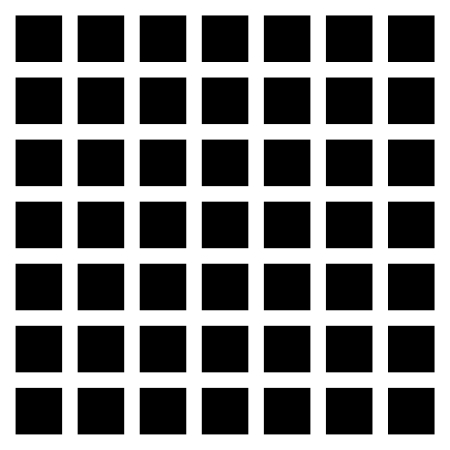
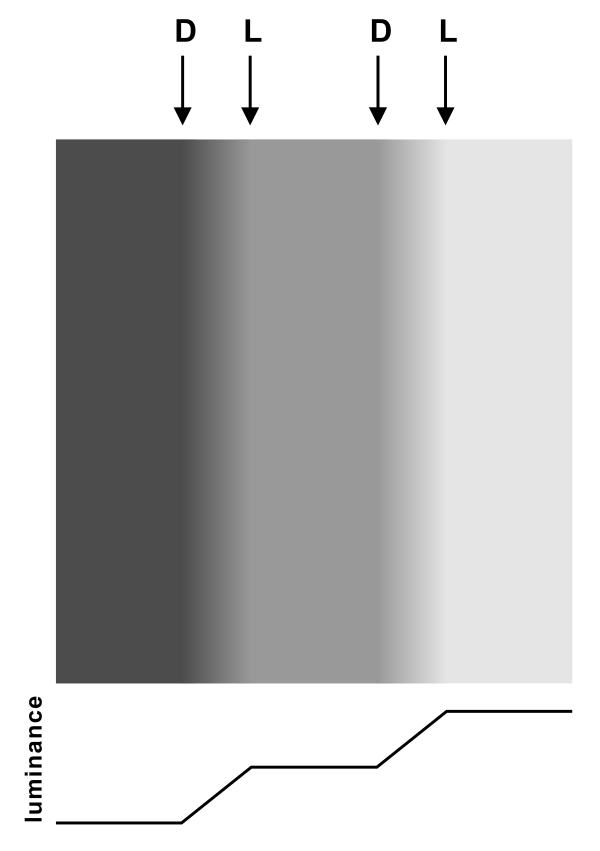
ヘルマン格子錯視とマッハの帯
色の対比と色の恒常性
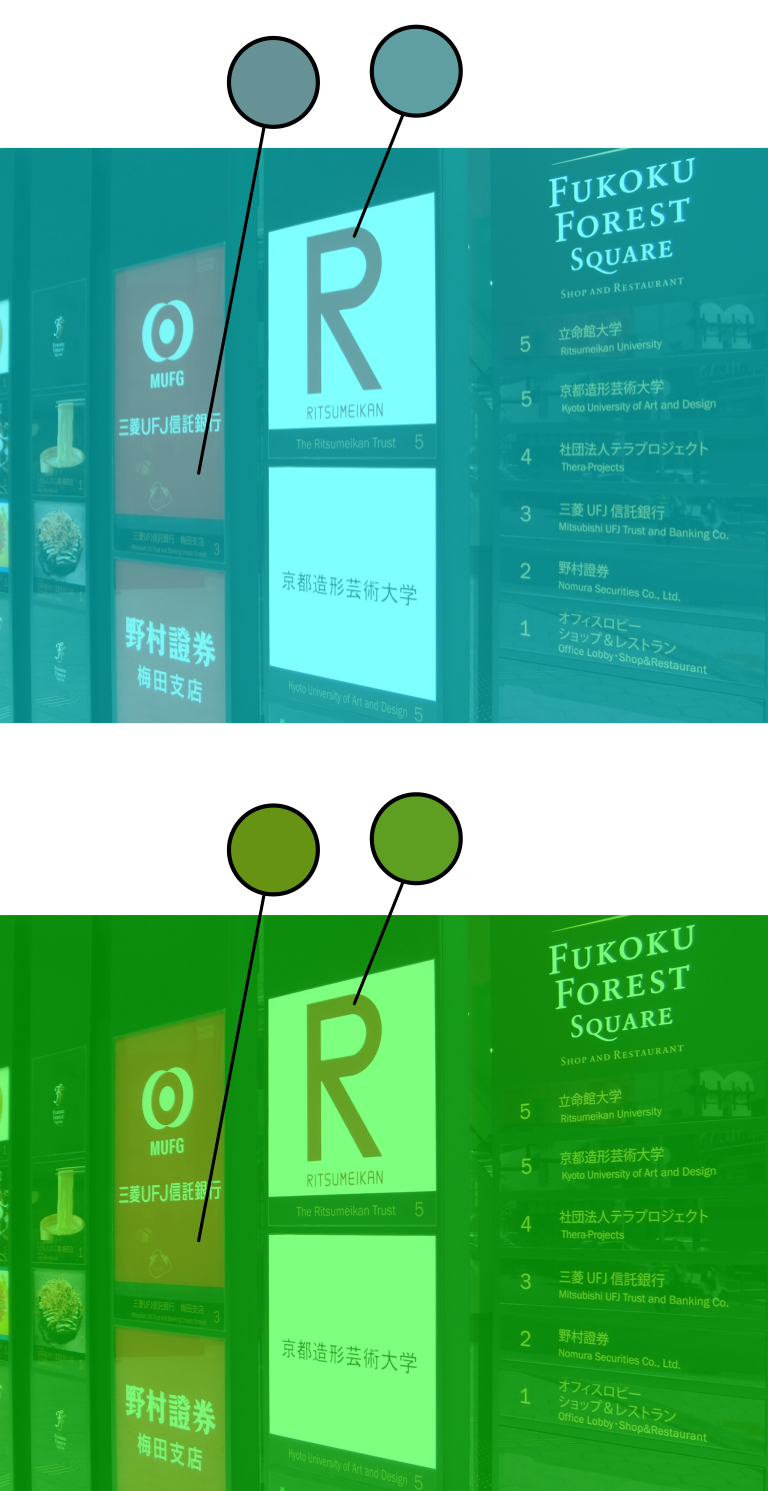
立命館大阪キャンパスの看板を使った色の恒常性デモ

Copyright Akiyoshi .Kitaoka 2009 (September 22)
(The handout)
北岡明佳 (2011) 色の錯視いろいろ (3)「トーンの錯視」 日本色彩学会誌, 35(4), 344-345. PDF(高解像度スキャンコピー)
北岡明佳 (2011) 色の錯視いろいろ (2)色の恒常性と2つの色フィルタ 日本色彩学会誌, 35(3), 234-236. PDF(スキャンコピー), PDF(高解像度スキャンコピー)
北岡明佳 (2011) 色の錯視いろいろ (1)「目の色の恒常性」という錯視の絵 日本色彩学会誌, 35(2), 118-119. PDF(スキャンコピー)
「遅延」錯視
「踊るハート達」
ハートが動いて見える。めがねをかけている人は、めがねを動かすとよく見えるかもしれない。離れたところから見ると、明るくなった時のハートは白のランダムドットより手前に見え、暗くなった時のハートは奥に見える人が過半数と予想される。
Copyright Akiyoshi Kitaoka 2006 (December 20)
<配布プリント>
モノクロでOK
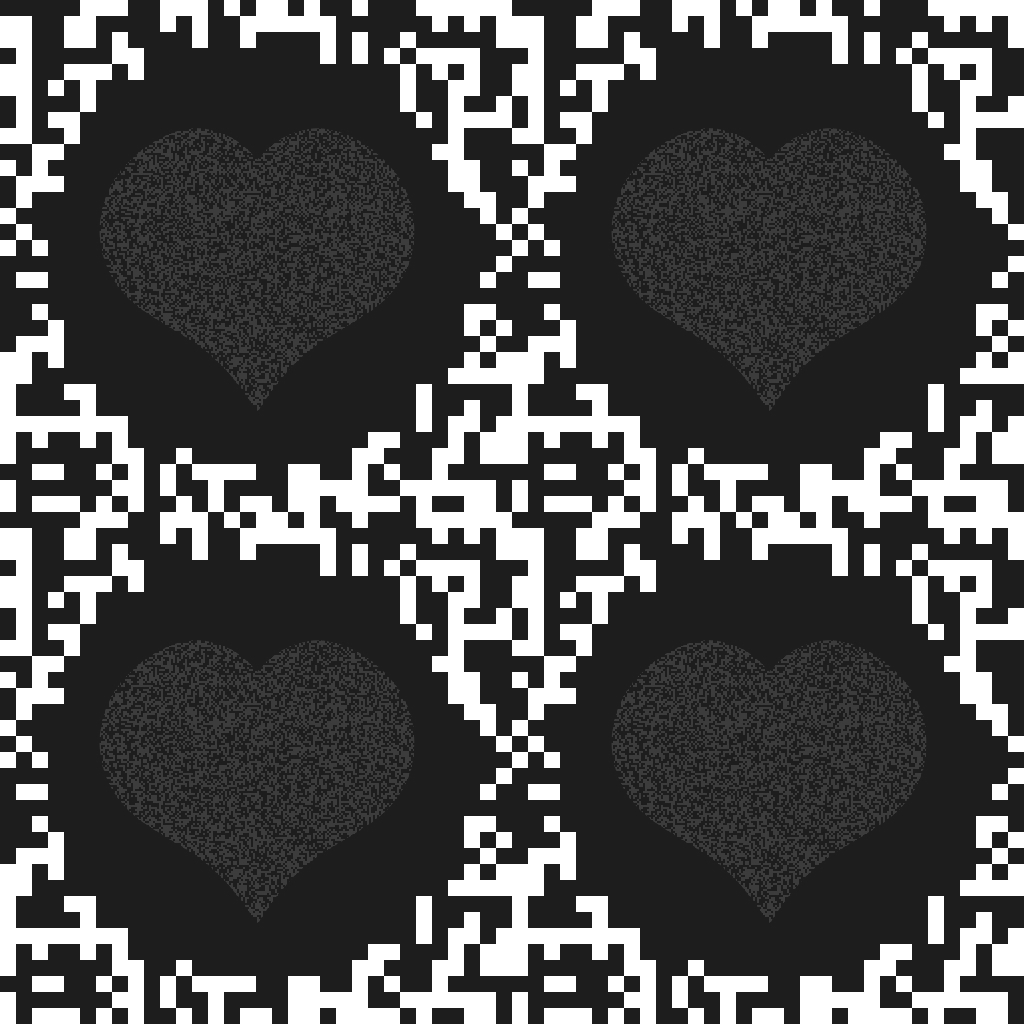
配布物
「踊るハート達」 (MS-Word ファイル)
北岡明佳 (2006) 色が強くなる錯視 A・F・Tジャーナル, 31 (Summer), pp. 01.
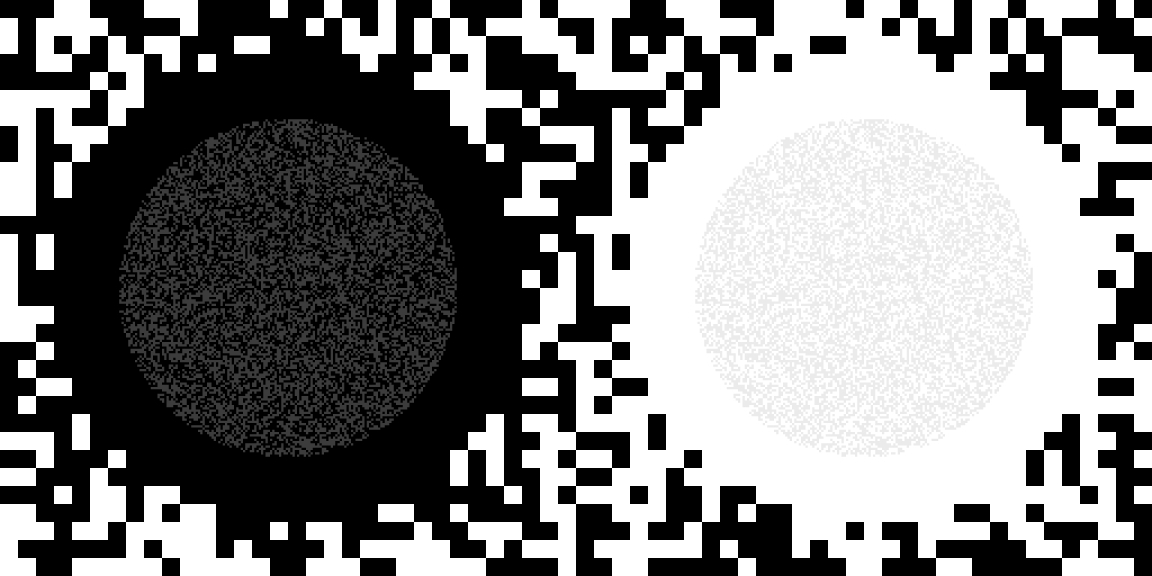
低輝度→脳内処理時間が長い
cf. プルフリッヒ効果
低輝度コントラスト→脳内処理時間が長い <our finding!>
1. High-luminance parts show shorter latency than low-luminance part.
2. High-contrast parts show shorter latency than low-contrast part. <our finding!>
Kitaoka, A. and Ashida, H. (2007) A variant of the anomalous motion illusion based upon contrast and visual latency. Perception, 36, 1019-1035. PDF
cf.
踊るハート(fluttering-heart illusion)

(Helmholtz, 1867; Nguyen-Tri and Faubert 2003; von Grünau 1975a, 1975b, 1976; von Kries 1896)
中山(2008)によると、踊るハートは赤が重要。青不要。ピンクはダメ。
中山明子 (2008) 「踊るハート」錯視(1844)と「踊るハート達」錯視(2006)の比較検証 2008年度立命館大学文学部(人文学科心理学専攻)卒業論文
渦巻き錯視
同心円(中心が同じ複数の円)が渦巻きに見える現象(網膜説は取りにくい)
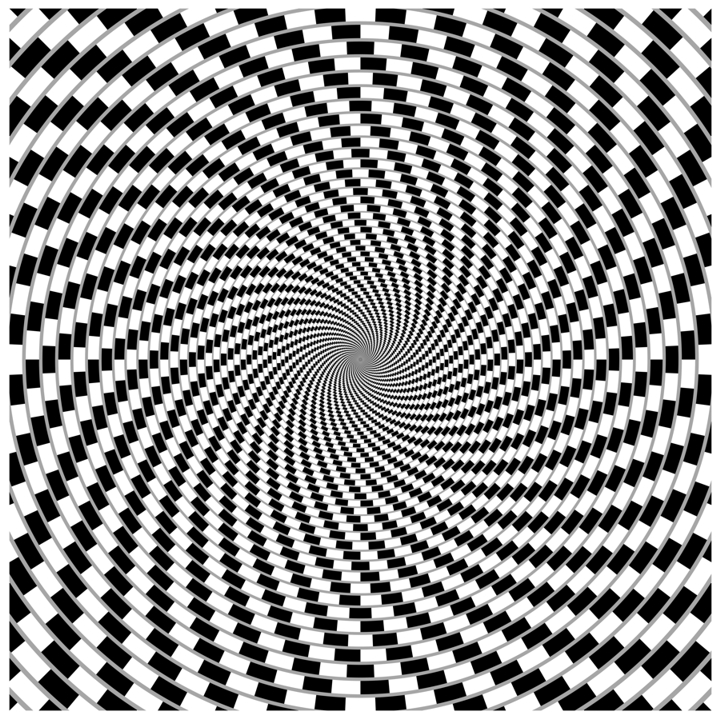
「カフェウォール渦巻き 2011年リメーク版」
灰色の同心円が左に回転して中心に向かう渦巻きに見える。
Copyright Akiyoshi Kitaoka 2011 (March 1)
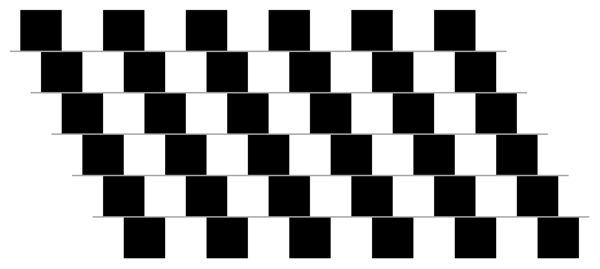
カフェウォール錯視
灰色の水平線が左に傾いて見える。
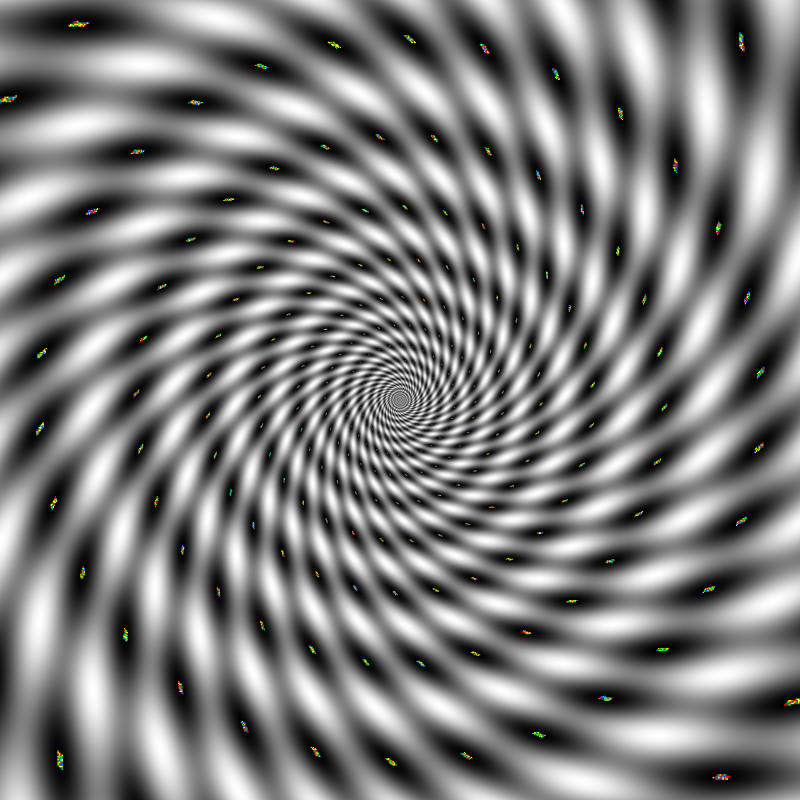
"Spiral warp"
Concentric rings appear to be spirals.
Copyright Akiyoshi Kitaoka 2007 (June 29)
equiangle = 45 deg
The spiral illusion of the Zöllner illusion:
Kitaoka, A., Pinna, B., and Brelstaff, G. (2001). New variations of spiral illusions. Perception, 30, 637-646.
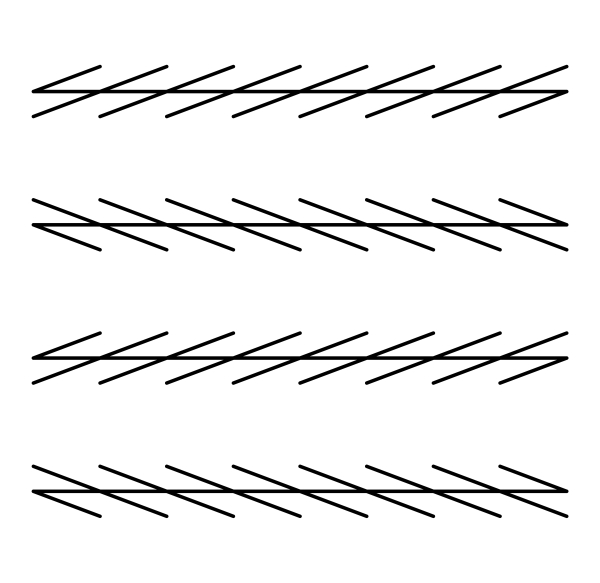
ツェルナー錯視
水平線が上から交互に右・左・右・左に傾いて見える。
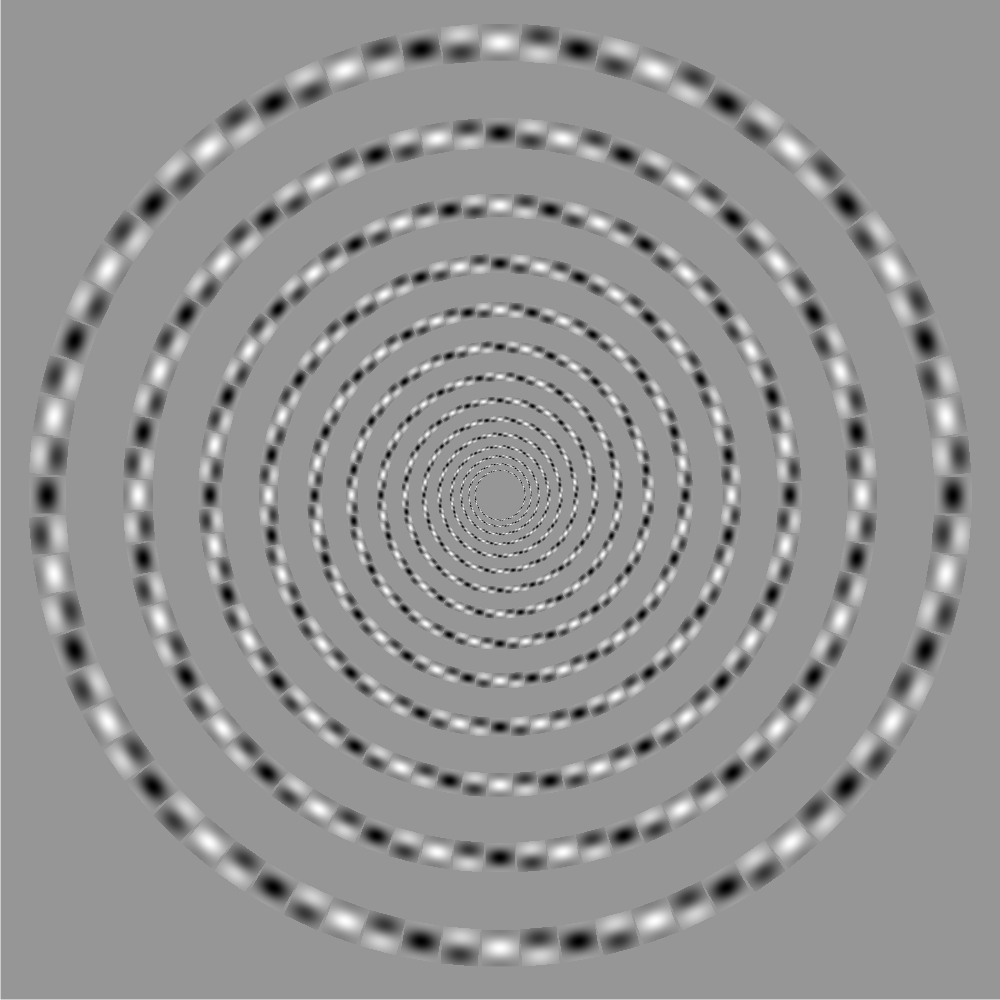
"Cyanophyceae spiral"
Concentric circles appear to be a spiral.
Copyright Akiyoshi Kitaoka 2007 (August 29)
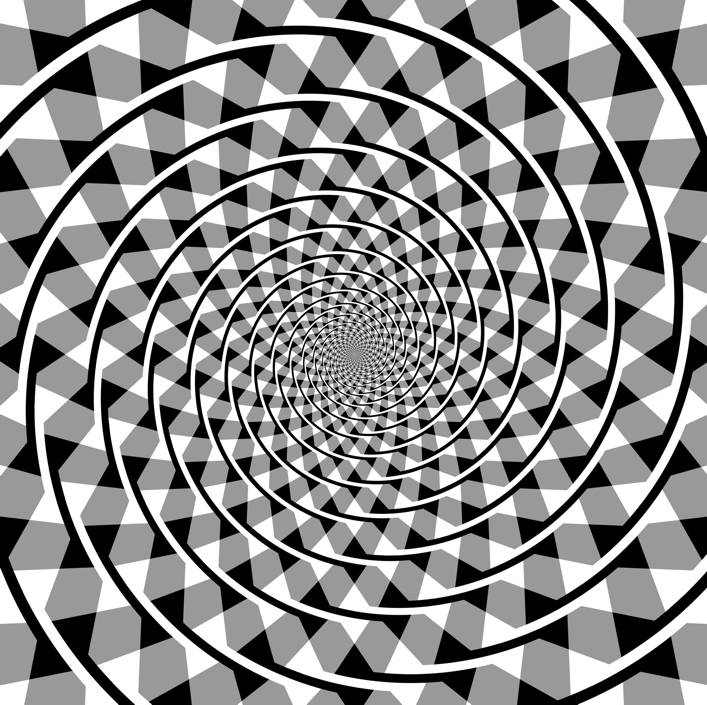
First presented by Fraser (1908); Reproduced by Akiyoshi Kitaoka (2009)
Fraser's spiral
The term "spiral illusion" had long referred to the spiral illusion of the Fraser illusion (Fraser, 1908) before we elucidated that any tilt illusion can form spiral illusion (Kitaoka, Pinna and Brelstaff, 2001). This page shows a copy of Fraser's spiral produced by PC programming. <2003/8/30>
Fraser, J. (1908) A new visual illusion of direction. British Journal of Psychology, 2, 307-320.
北岡明佳 (2006) 渦巻き錯視のメカニズム じっきょう数学資料, 52, 13-15. PDF
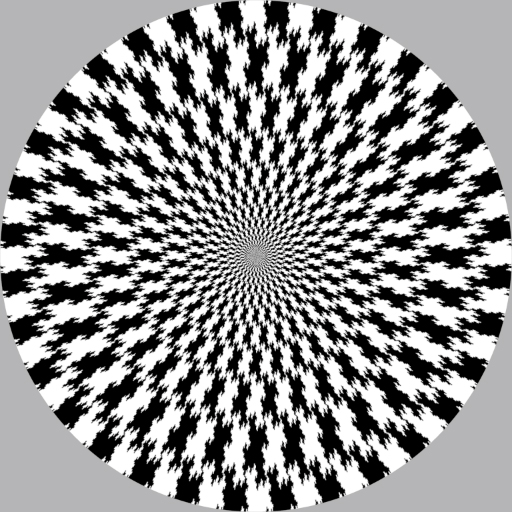
"Fractal spiral illusion"
Concentric rings made up of fractal islands appear to form spirals.
Copyright Hitoshi & Shinobu Arai
2007
from Professor Hitoshi Arai,
Graduate School of Mathematical Sciences, University of Tokyo, October 4,
2007
北岡明佳のコメント: 原理としてはフレーザー錯視のようですが、それよりもなによりも、世界初のフラクタル錯視図形 なのではないでしょうか!? 新井先生の視覚数学e研究室報告に、この錯視の論文が出ました。 <2007年10月4日>
Suggested function
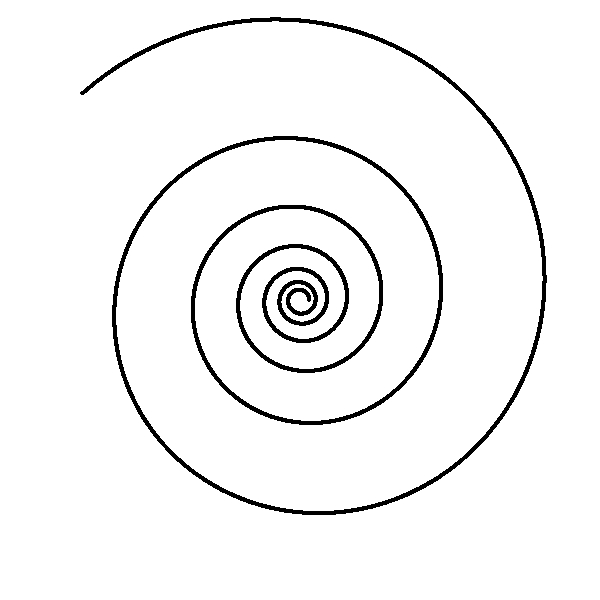
Bernoulli's spiral
r = a exp (k θ)
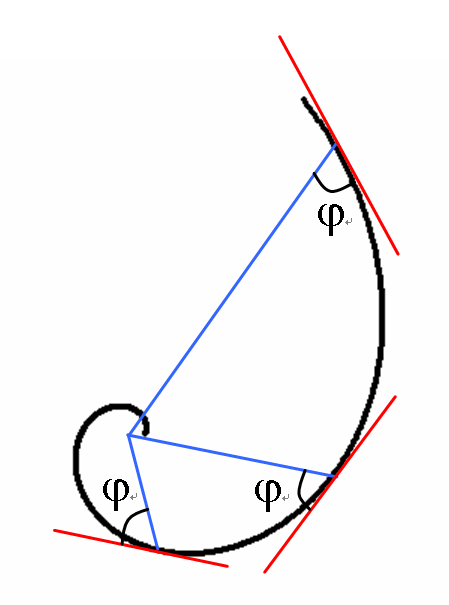
= equiangular spiral
k = 1 / tan (φ)
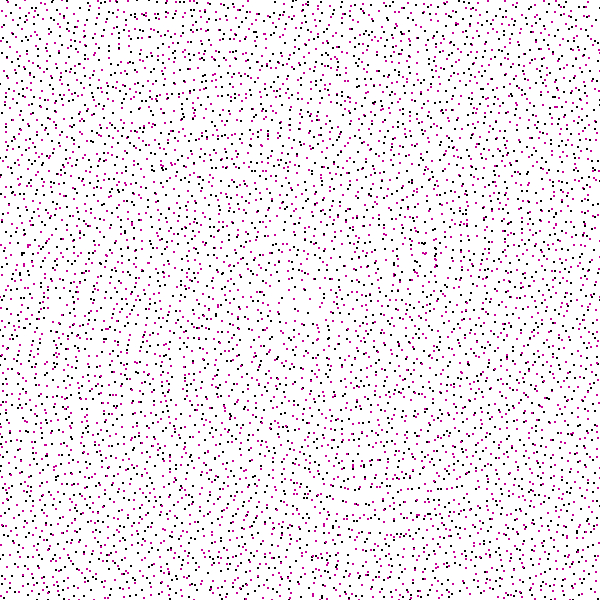
Spiral Glass pattern
φ = 70º
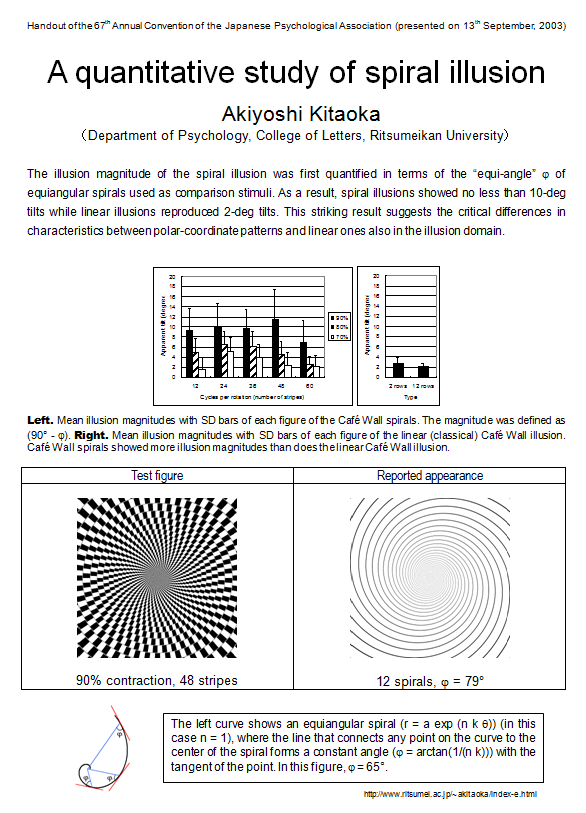
結論 渦巻き錯視はベルヌーイ螺旋の知覚メカニズムで説明できる。
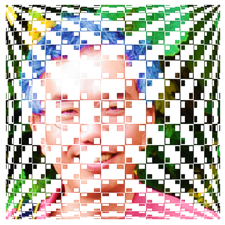 Kitaoka, A., Pinna, B., and Brelstaff, G. (2001). New variations of spiral illusions. Perception, 30, 637-646. PDF
Kitaoka, A., Pinna, B., and Brelstaff, G. (2001). New variations of spiral illusions. Perception, 30, 637-646. PDF
長(おさ)の角度錯視

「上賀茂神社の長(おさ)錯視」
参道の両端の斜線の成す角度は鋭角に見えるが、実際には鈍角である(下図参照)。
Osa A, Nagata K, Honda Y, Ichikawa M, Matsuda
K, Miike H, 2011, "Angle illusion in a straight road" Perception 40(11) 1350 –
1356
http://www.perceptionweb.com/abstract.cgi?id=p7068
Copyright Akiyoshi Kitaoka 2010 (December 28)
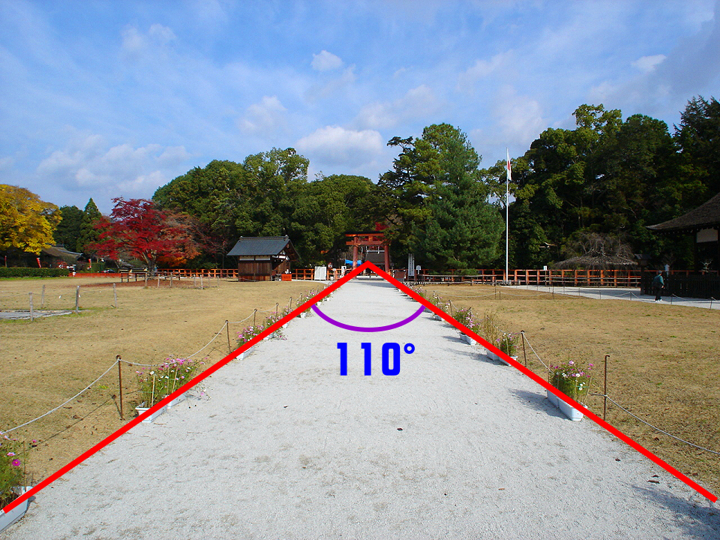
<2012年1月8日>
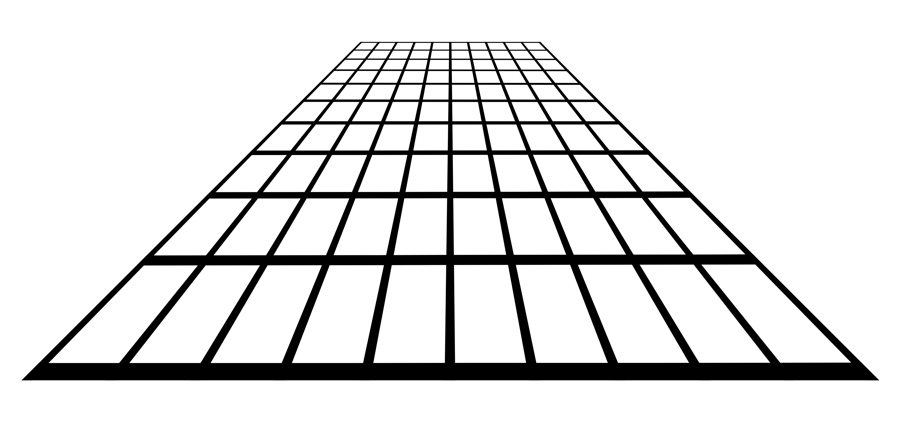
斜辺の成す角度は90度であるが、鋭角に見える。
「敬学館地下の長錯視」
廊下の両端の斜線の成す角度は鋭角に見えるが、実際には鈍角である(下図参照)。長錯視については、現在のところこちらを参照。
Copyright Akiyoshi Kitaoka 2010 (December 28)
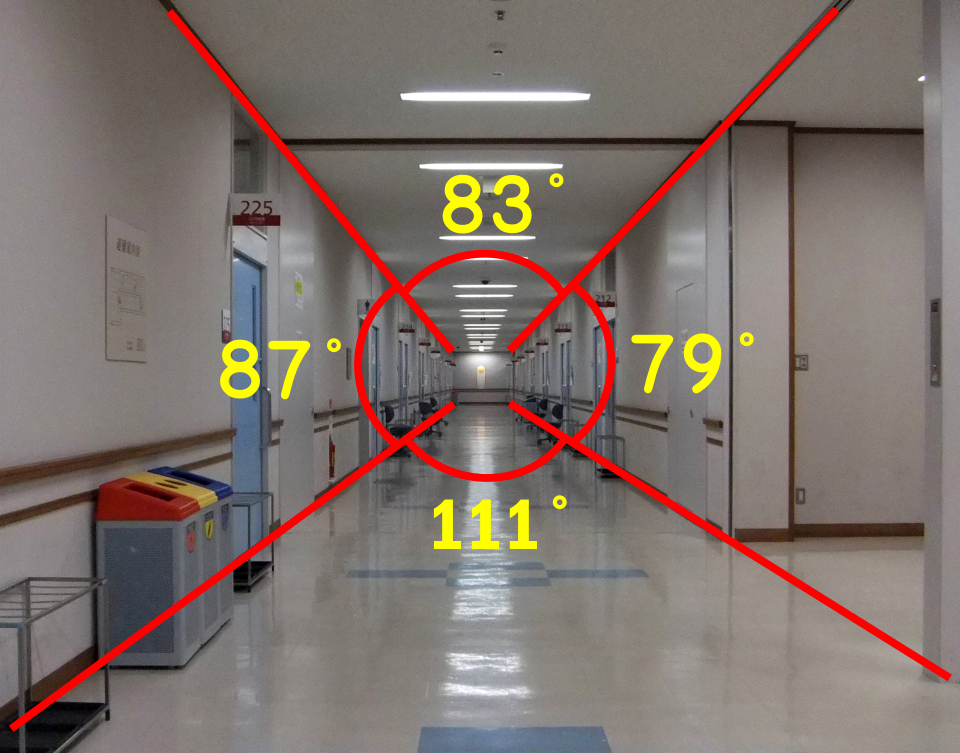
Copyright Aliyoshi Kitaoka 2011 (February 3)
奥行き方向に傾いた対象が与える網膜像は遠くに知覚されるものほど大きくみえるという錯視
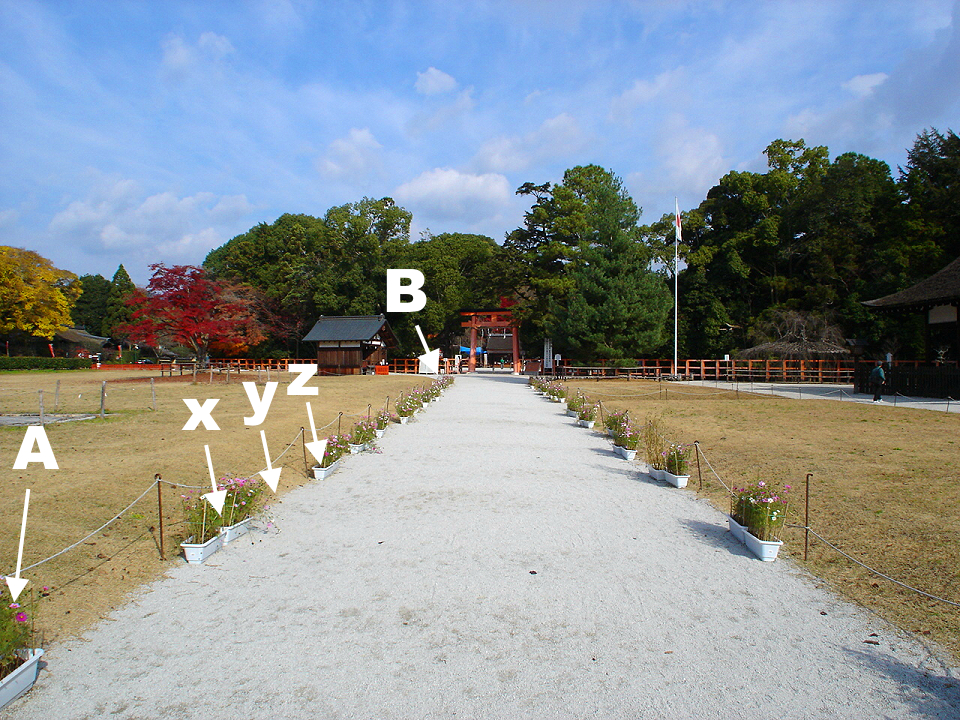
「上賀茂神社距離錯視」
A と B のフラワーポットの絵画上の中間点は、x y z のうちどれが一番近いか?
Copyright Akiyoshi Kitaoka 2012 (March 10)

答え: x が絵画上の中間点である。絵画上の中間点は y のあたりに見えるかもしれないがそれは錯視である。
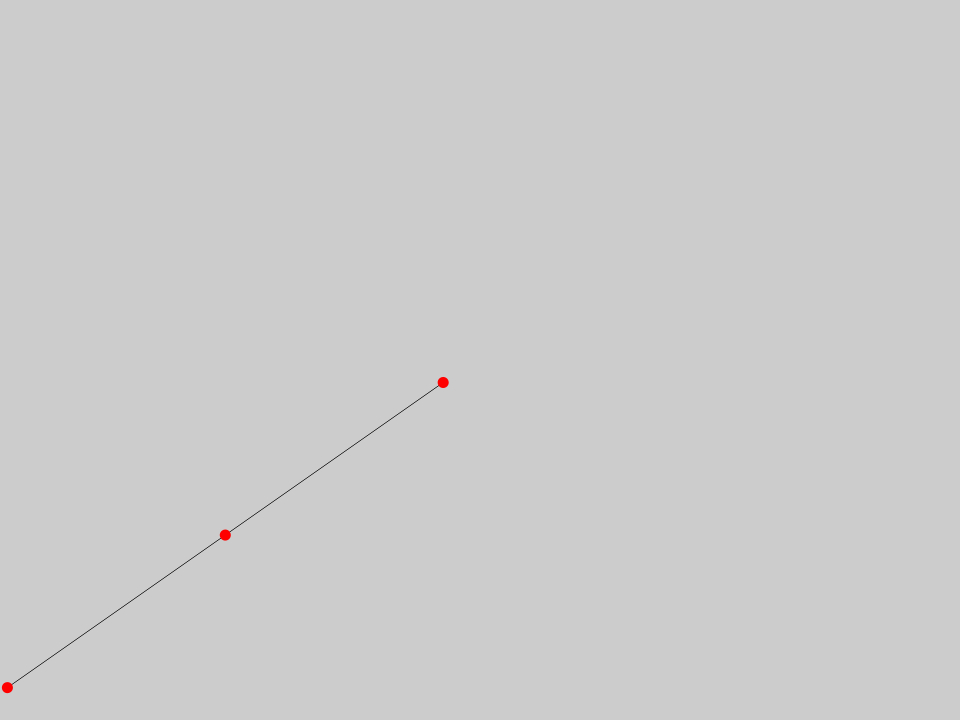
答えの図でもまだ錯視が残るので、確認のために示す。
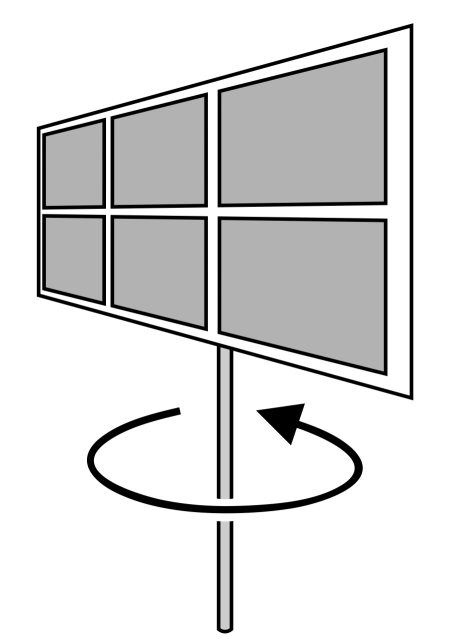
エイムズの台形窓
棒は台形の中線の延長線上にあるが、右に寄って見える。
「距離錯視」
この図の輪郭である台形の上辺と下辺の中線はどのあたりか?
Copyright Akiyoshi Kitaoka 2012 (March 11)
下辺より2本目より少し上あたりのように見えるが、2本目より少し下である。カーソルを置くと赤線で示される。
傾き錯視と同居する静止画が動いて見える錯視群
Tilt illusion is a subcategory of geometrical illusion, in which lines or edges appear to tilt clockwise or counterclockwise. (e.g., Zöllner illusion, Fraser illusion, Café Wall illusion)
Anomalous motion illusion refers to motion illusion in a stationary image, in which part of the
stationary image appears to move. (e.g., Ouchi illusion, Enigma illusion,
optimized Fraser-Wilcox illusion)
Some* types of tilt illusions are accompanied by anomalous motion illusion. (e.g., Illusion of Y-junctions)
*Later, I have realized that most of tilt illusions (including the Fraser illusion and the Café Wall illusion) share the same image with anomalous motion illusion.
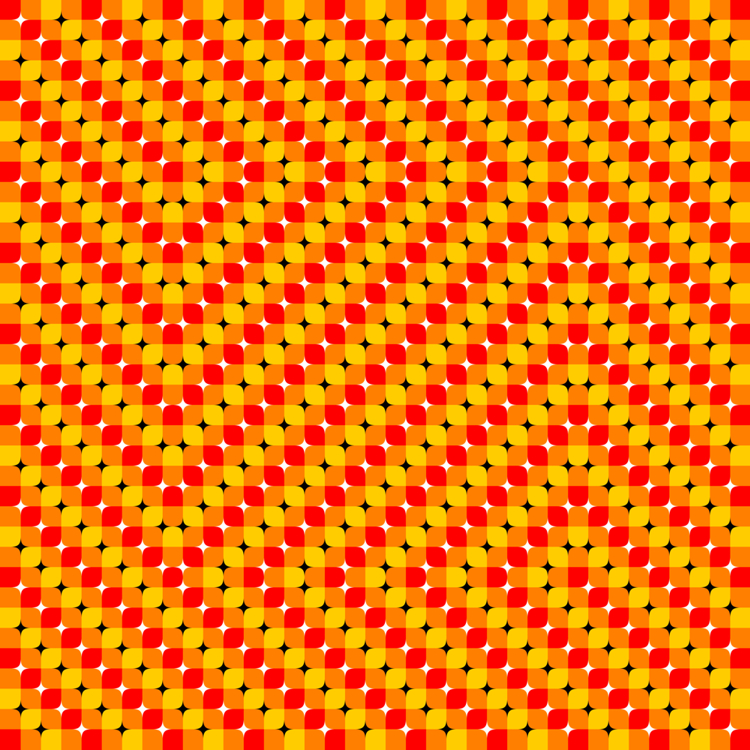
"The autumn color swamp"
The inset appears to move.
Copyright A.Kitaoka 2000, 2003, 2007, 2010
<Handout>
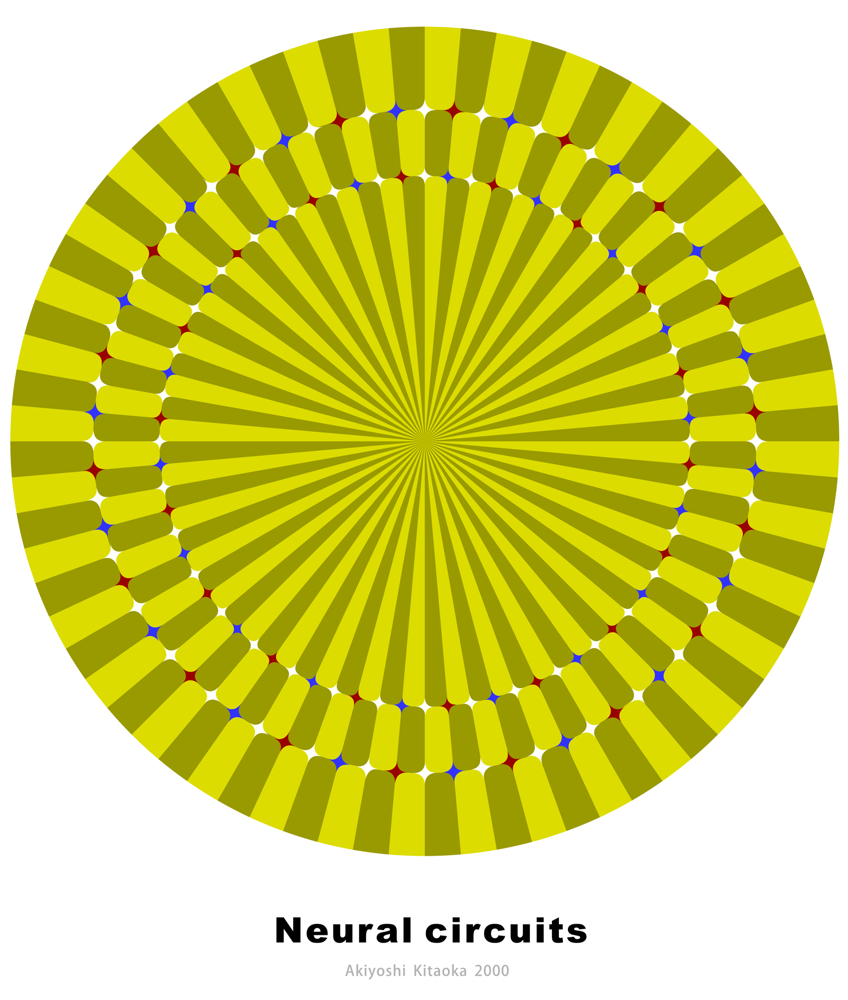
The two concentric arrays of stars appear to rotate in the different directions when we approach or move away from the figure while fixating at the center.
Copyright Akiyoshi Kitaoka 2000, 2010
<Handout>
Illusion of Y-junctions

The elemental image as the tilt illusion
The horizontal edge on which black or white stars are placed appears to tilt counterclockwise.
Kitaoka, A., Pinna, B., and Brelstaff, G. (2001). New variations of spiral
illusions. Perception, 30, 637-646.
Kitaoka, A., Pinna, B., and Brelstaff, G. (2004). Contrast polarities determine the direction of Cafe Wall tilts. Perception, 33, 11-20.
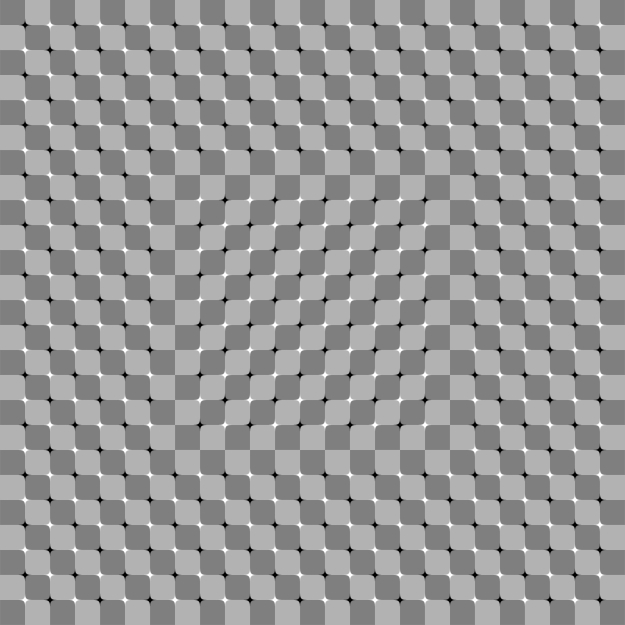
The elemental image as anomalous motion illusion
The inset appears to move. When the retinal image is moved vertically, the inset appears to move horizontally. When the retinal image is moved horizontally, the inset appears to move vertically.
<Handout>
Today's talk
1. "Discovery" of the Fraser illusion family
2. Anomalous motion illusion accompanied by tilt illusion
3. A speculation of the "Rotating snakes" illusion
§1. "Discovery" of the Fraser illusion family
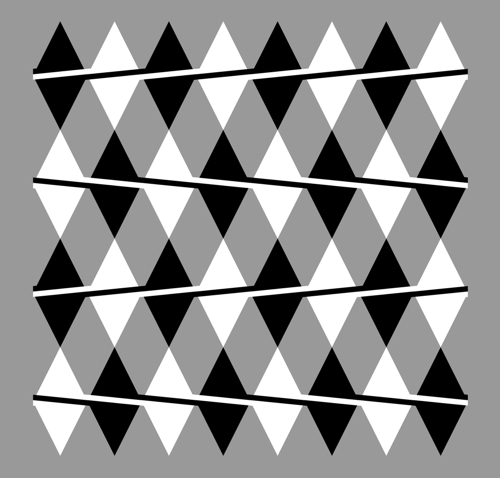
Fraser illusion
"Twisted cords" are horizontally aligned but appear to tilt alternately. The apparent tilt is the same orientation as the tilt of each obliques.
Drawn by Akiyoshi Kitaoka 2010 (March 20)
Fraser, J. (1908) A new visual illusion of direction. British Journal of Psychology, 2, 307-320.
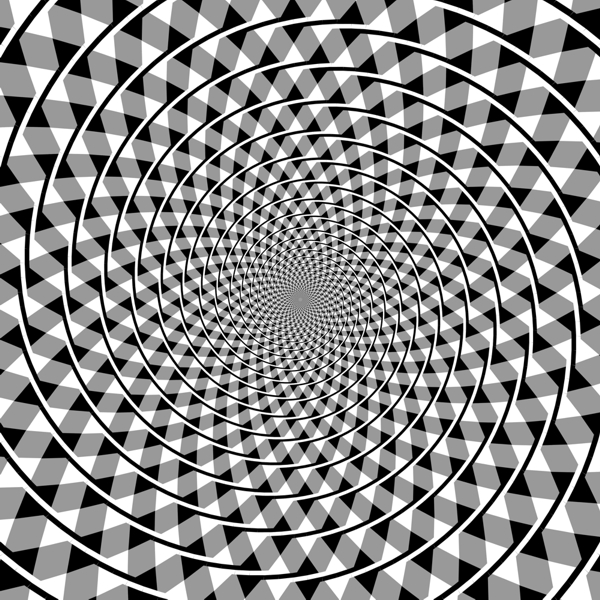
Fraser's spiral
(spiral illusion of the Fraser illusion)
Concentric circles of "twisted cords" appear to be spirals.
Drawn by Akiyoshi Kitaoka 2010 (March 20)
Fraser, J. (1908) A new visual illusion of direction. British Journal of Psychology, 2, 307-320.
<Handout>
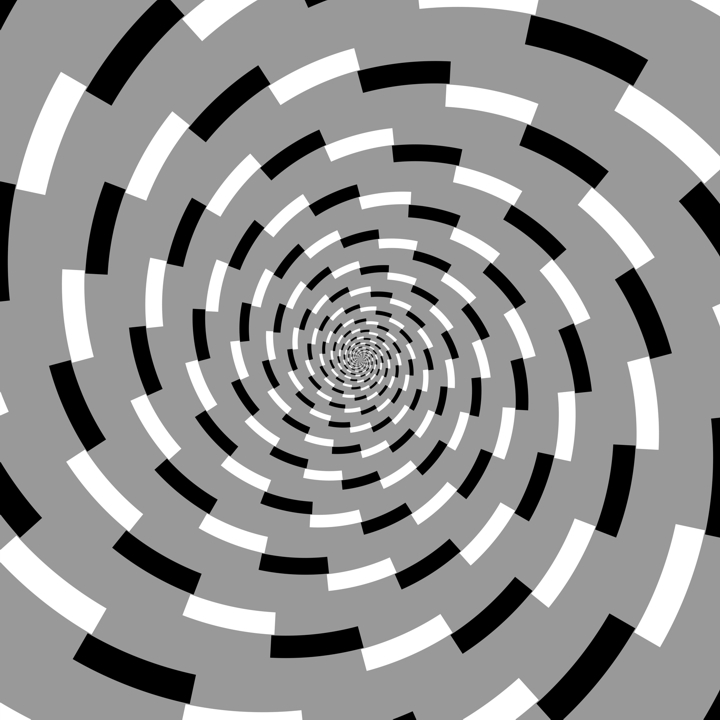
In December 2009, I developed a "new" illusion (though it essentially was not new), which I called the "pseudo Fraser illusion".
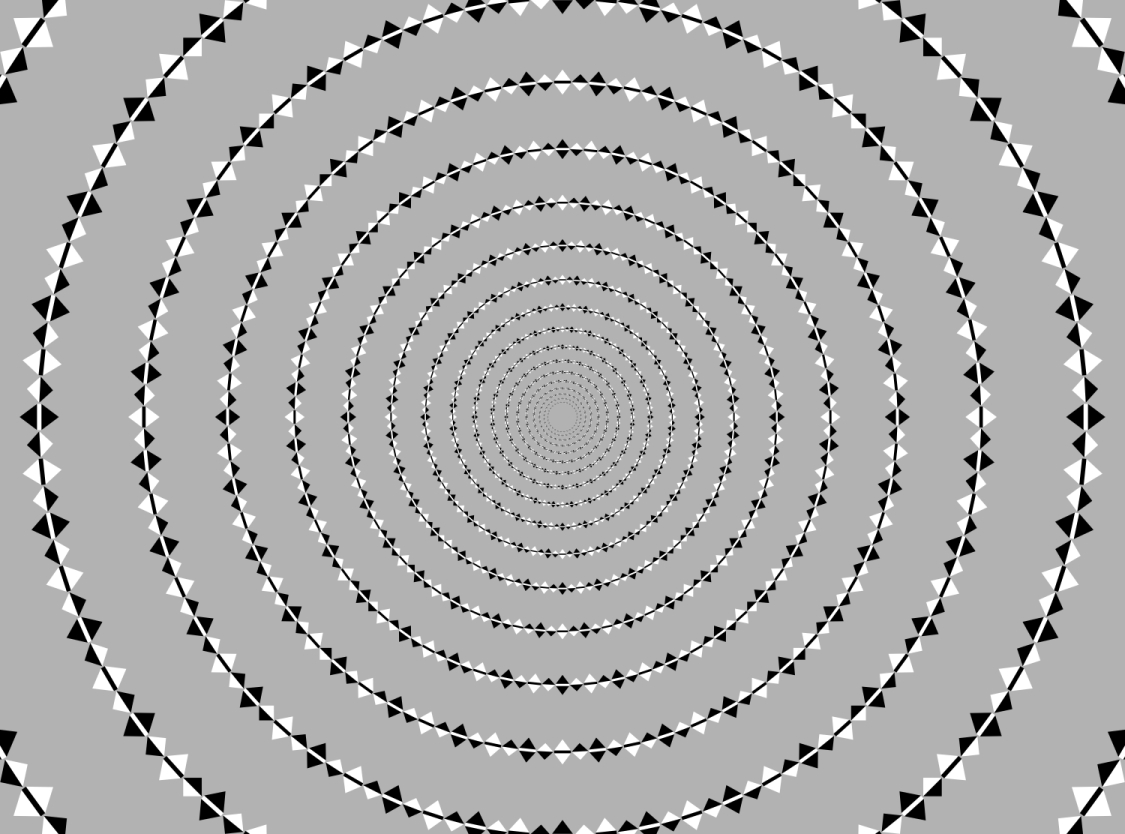
"Pseudo Fraser
spirals"
Concentric rings appear to be spirals.
Copyright Akiyoshi Kitaoka 2009 (December 17)
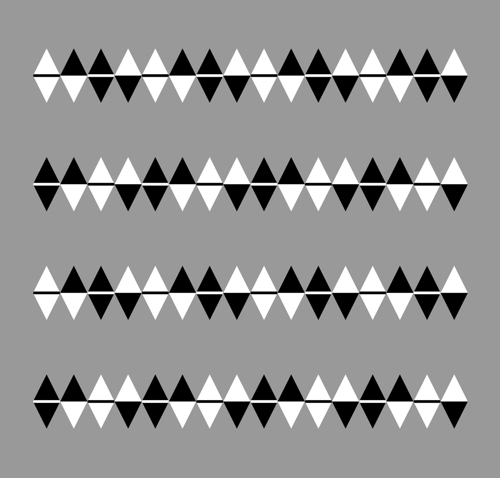
Psudo-Fraser illusion
("Fraser's Café Wall" illusion)
The middle lines are horizontally aligned but appear to tilt alternately. The apparent tilt is counterclockwise, clockwise, and so on from the top row.
Drawn by Akiyoshi Kitaoka 2010 (March 20)
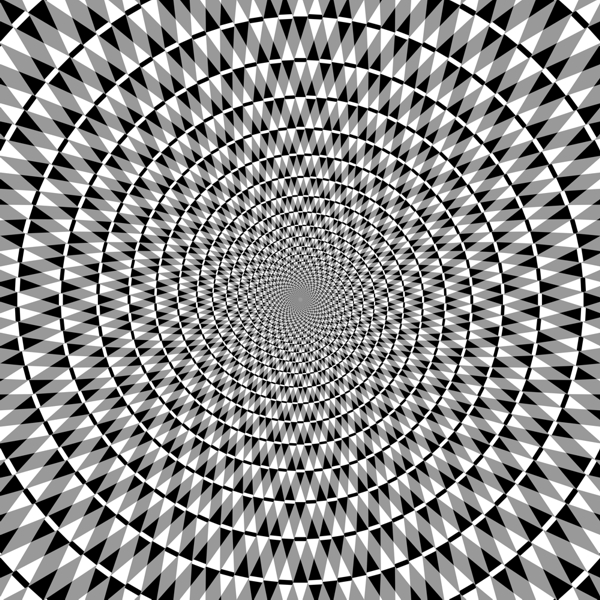
Pseudo-Fraser's spiral
(spiral illusion of the "Fraser Café Wall" illusion)
Concentric circles of "twisted cords" appear to be spirals.
Drawn by Akiyoshi Kitaoka 2010 (March 20)
Q. What are the differences between the Fraser illusion and the pseudo-Fraser illusion?
A. There are three factors involved:
1. whether the inducers are obliques (Fraser illusion) or not (pseudo-Fraser illusion)
2. whether the inducers are only lines (Fraser illusion) or combination of lines and edges (pseudo-Fraser illusion)
3. whether the inducers are two (Fraser illusion) or four (pseudo-Fraser illusion)
1. whether the inducers are obliques (Fraser illusion) or not (pseudo-Fraser illusion)
Finding: There are counterparts of the Fraser illusion as well as the pseudo-Fraser illusion, respectively

Fraser illusion
"Twisted cords" are horizontally aligned but appear to tilt alternately. The apparent tilt is the same orientation as the tilt of each obliques.
Drawn by Akiyoshi Kitaoka 2010 (March 20)
Fraser, J. (1908) A new visual illusion of direction. British Journal of Psychology, 2, 307-320.
The counterpart of the Fraser illusion
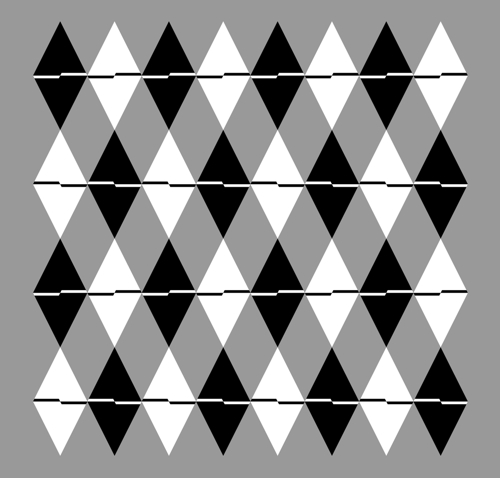
Illusion of shifted lines
Rows of middle line segments are horizontally aligned but appear to tilt alternately. The apparent tilt is counterclockwise, clockwise, and so on from the top row.
Drawn by Akiyoshi Kitaoka 2010 (March 20)
Kitaoka, A. (2007) Tilt illusions after Oyama (1960): A review. Japanese Psychological Research, 49, 7-19.

Psudo-Fraser illusion
("Fraser's Café Wall" illusion)
The middle lines are horizontally aligned but appear to tilt alternately. The apparent tilt is counterclockwise, clockwise, and so on from the top row.
Drawn by Akiyoshi Kitaoka 2010 (March 20)
The counterpart of the pseudo-Fraser illusion

The patterns like "twisted cords" are horizontally aligned but appear to tilt alternately. The apparent tilt is the same orientation as the tilt of each obliques.
Drawn by Akiyoshi Kitaoka 2010 (March 20)
2. whether the inducers are only lines (Fraser illusion) or combination of lines and edges (pseudo-Fraser illusion)
Finding: There are three groups in this sense, only lines, combinations of lines and edges, and only edges, respectively
Lines only

Fraser illusion
"Twisted cords" are horizontally aligned but appear to tilt alternately. The apparent tilt is the same orientation as the tilt of each obliques.
Drawn by Akiyoshi Kitaoka 2010 (March 20)
Fraser, J. (1908) A new visual illusion of direction. British Journal of Psychology, 2, 307-320.
Combination of lines and edges
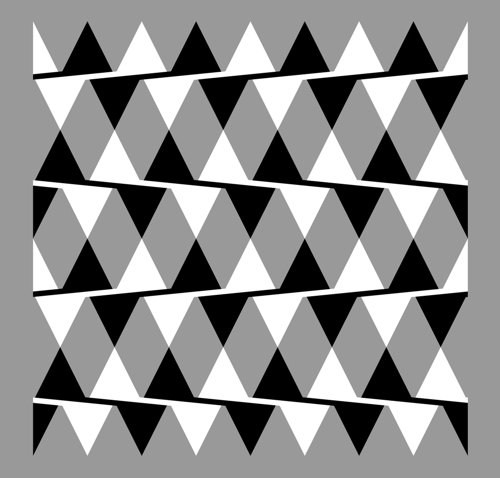
"Cafe Wall Fraser" illusion
The patterns like "twisted cords" are horizontally aligned but appear to tilt alternately. The apparent tilt is the same orientation as the tilt of each obliques.
Drawn by Akiyoshi Kitaoka 2010 (March 20)
Fraser, J. (1908) A new visual illusion of direction. British Journal of Psychology, 2, 307-320.
Edges only

Illusion of oblique edges
Rows of oblique edges are horizontally aligned but appear to tilt alternately. The apparent tilt is the same orientation as the tilt of each obliques.
Drawn by Akiyoshi Kitaoka 2010 (March 20)
Kitaoka, A. (2007) Tilt illusions after Oyama (1960): A review. Japanese Psychological Research, 49, 7-19.
3. whether the inducers are two (Fraser illusion) or four (pseudo-Fraser illusion)
Finding: The basic components of the Fraser illusion can be counted four to match the pseudo-Fraser illusion. In the same way, The basic components of the pseudo-Fraser illusion can be counted two to match the Fraser illusion. Thus, this factor is not essential for tilt illusion.

Fraser illusion
"Twisted cords" are horizontally aligned but appear to tilt alternately. The apparent tilt is the same orientation as the tilt of each obliques.
Drawn by Akiyoshi Kitaoka 2010 (March 20)
Fraser, J. (1908) A new visual illusion of direction. British Journal of Psychology, 2, 307-320.
The counterpart of the Fraser illusion
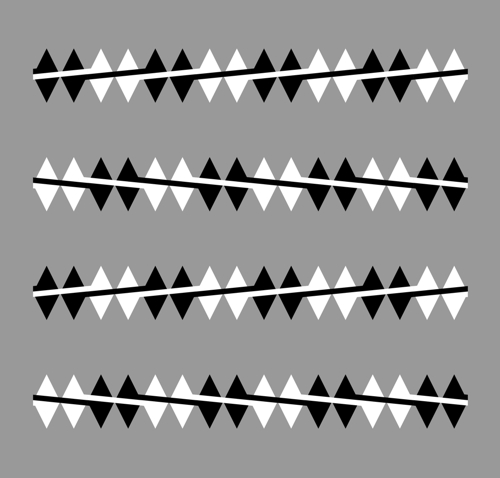
Fraser illusion
"Twisted cords" are horizontally aligned but appear to tilt alternately. The apparent tilt is the same orientation as the tilt of each obliques.
Drawn by Akiyoshi Kitaoka 2010 (March 20)
Fraser, J. (1908) A new visual illusion of direction. British Journal of Psychology, 2, 307-320.

Psudo-Fraser illusion
("Fraser's Café Wall" illusion)
The middle lines are horizontally aligned but appear to tilt alternately. The apparent tilt is counterclockwise, clockwise, and so on from the top row.
Drawn by Akiyoshi Kitaoka 2010 (March 20)
The counterpart of the pseudo-Fraser illusion
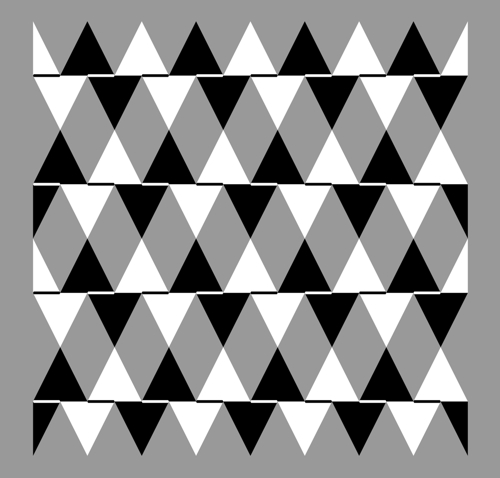
Psudo-Fraser illusion
("Fraser's Café Wall" illusion)
The middle lines are horizontally aligned but appear to tilt alternately. The apparent tilt is counterclockwise, clockwise, and so on from the top row.
Drawn by Akiyoshi Kitaoka 2010 (March 20)
cf. Fraser, J. (1908) A new visual illusion of direction. British Journal of Psychology, 2, 307-320.
Conclusion: The Fraser illusion family consists of six (3 x 2) illusions.
<Handout>
Q. How is the pseudo-Fraser illusion related to the Café Wall illusion?
A. I think they are essentally the same illusion.
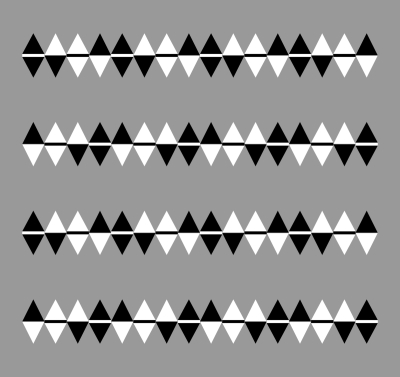
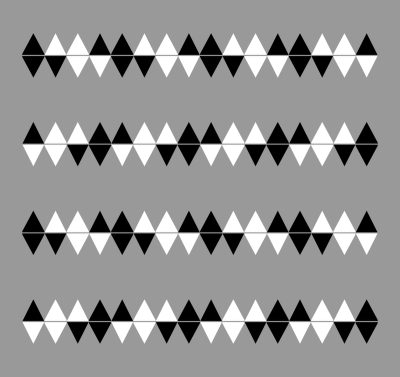
The pseudo-Fraser illusion (left) and the Café Wall illusion (right)
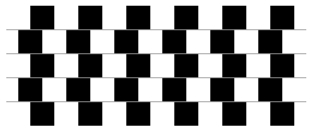
Café Wall illusion: a standard image
cf. Gregory, R. L. and Heard, P. (1979) Border locking and the Café Wall illusion. Perception, 8, 365-380.
Q. Does tilt illusion occur where contast polarity changes?
A. Yes, as if it were the reversed phi (the direction opposite to the shift).
(Illusion of oblique edges)
(Illusion of shifted lines)
Example
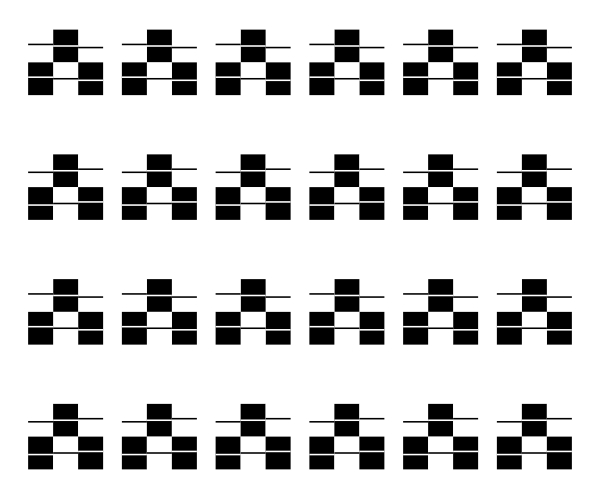
"Derby man tilt illusion"
Horizontally aligned rows of "derby men" appear to tilt alternately. From the top, counterclockwise, clockwise, and so on.
Copyright Akiyoshi Kitaoka 2010 (March 21)
My idea: There are eight fundamental combinations of basic components.
(I imagine that neurons with receptive fields like these play a part)
(The limiting case of the Fraser illusion family)
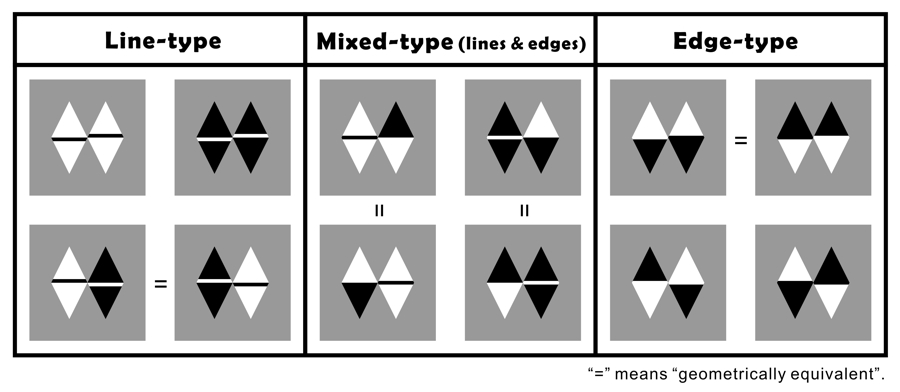
In each gray square, the middle line or edge appears to tilt counterclockwise.
Copyright Akiyoshi Kitaoka 2010 (March 22)
In addition: Café Wall illusion can be explained with this idea.

Café Wall illusion: a standard image
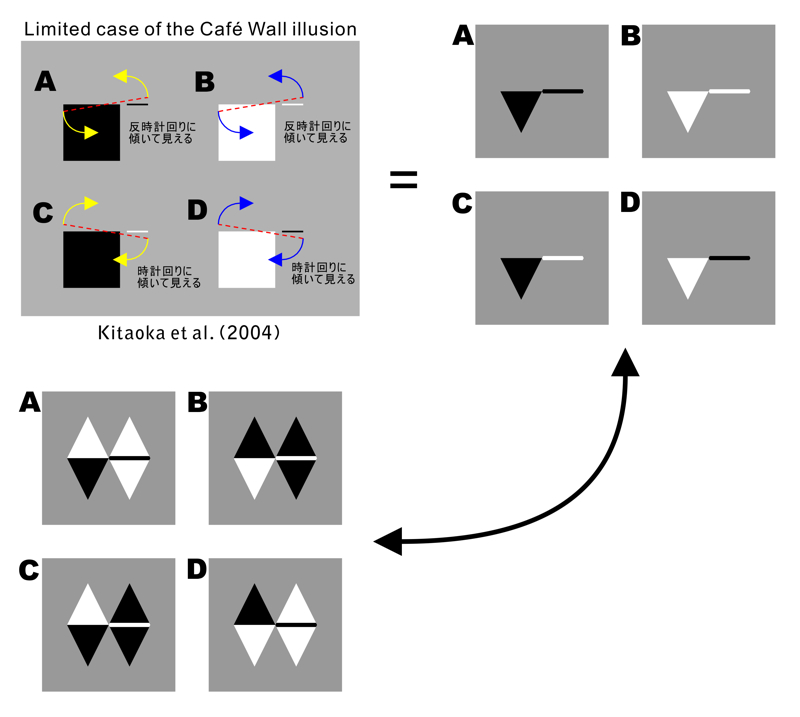
Copyright Akiyoshi Kitaoka 2010 (March 22)
Kitaoka, A., Pinna, B., and Brelstaff, G. (2004) Contrast polarities determine the direction of Café Wall tilts. Perception, 33, 11-20.
§2. Anomalous motion illusion accompanied by tilt illusion

"Obake-hime"
obake = ghost; hime = princess or girl
The face appears to expand; the group of bats appears to rotate counterclockwise. This is Professor Mather's four-stroke motion.
Copyright Akiyoshi Kitaoka 2009 (August 10)
Professor Mather's demonstration is the best.
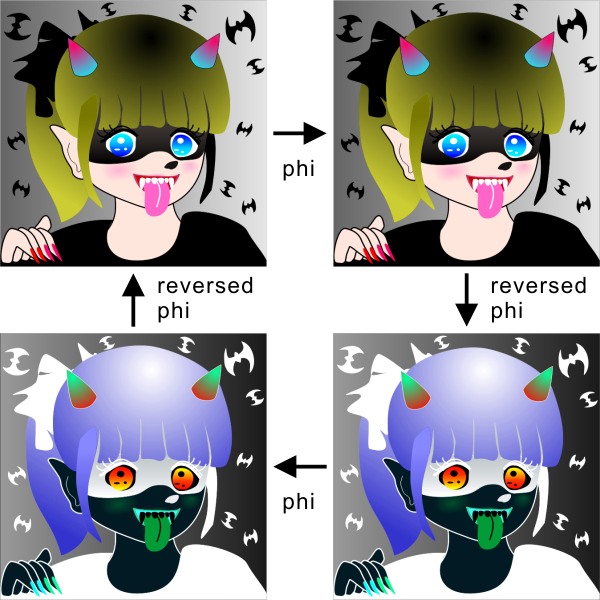
Copyright Akiyoshi Kitaoka 2010 (March 22)
(Reversed phi only)

Copyright Akiyoshi Kitaoka 2010 (March 22)
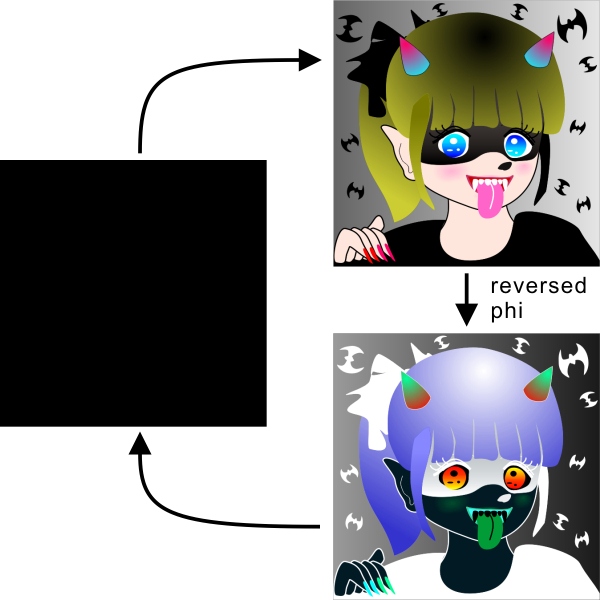
Reversed phi movement (Anstis and Rogers 1975). There are four rectangles, each of which is flanked by thin lines that are dark or light. When the luminance of the rectangles decreases and that of the background increases accordingly, the upper two appear to converge in motion while the lower two appear to go apart in motion. On the other hand, when the luminance of the rectangles increases and that of the background decreases accordingly, the upper two appear to go apart in motion while the lower two appear to approach each other in motion. In sum, the direction of apparent motion is from the dark flank to the neighboring part that goes darkening or from the light flank to the neighboring part that goes brightening. Although the rectangles are aligned vertically, the apparent positional displacement occurs in the opposite direction to motion. If observers cross-fuse (uncross-fuse) the right and left rectangles, the upper rectangle appears to be in front of (behind) the lower one when they are dark.
Kitaoka, A. (2006) Configurational coincidence
among six phenomena: A comment on van Lier and Csathó (2006). Perception,
35, 799-806. animations ![]()
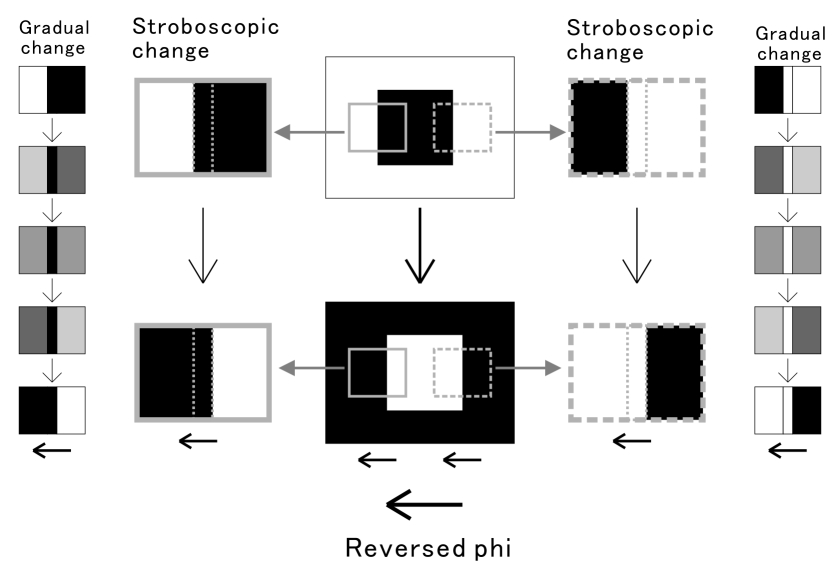
Anstis S M, 1970 “Phi movement as a subtraction process” Vision Research 10 1411-1430
Anstis S M, Rogers B J, 1975 “Illusory reversal of visual depth and movement during changes of contrast” Vision Research 15 957-961
4-stroke motion corresponding to the Line Type
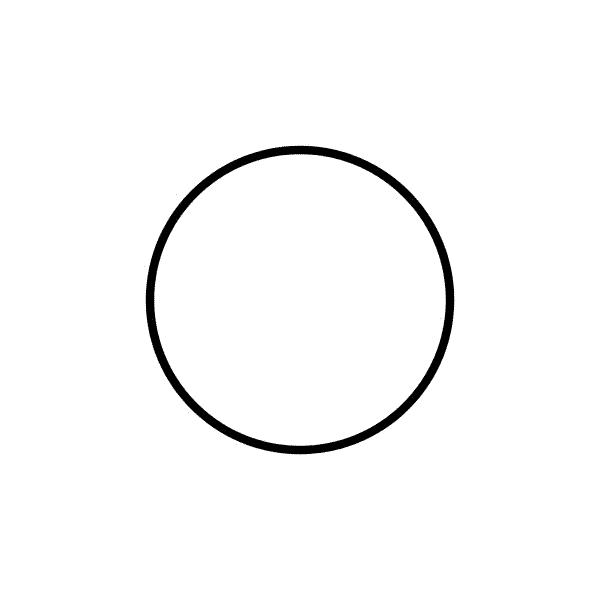
Copyright Akiyoshi Kitaoka 2010 (March 22)
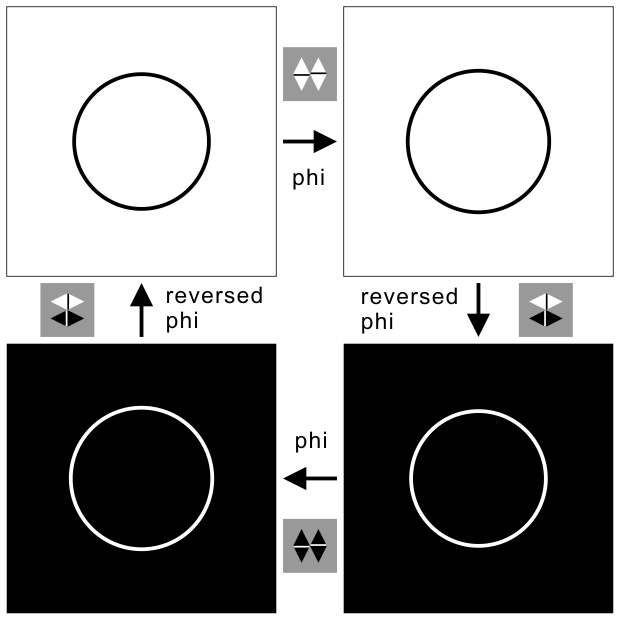
Finding: The direction of motion is the same as the tilt illusion.
Mather, G. and Murdoch, L. (1999) Second-order processing of four-stroke apparent motion. Vision Research, 39, 1795-1802.
cf. van Lier R, Csathó Á, 2005 “Dancing shapes: A comparison of luminance induced distortions” Perception, 35, 775 – 798.
4-stroke motion corresponding to the Edge Type
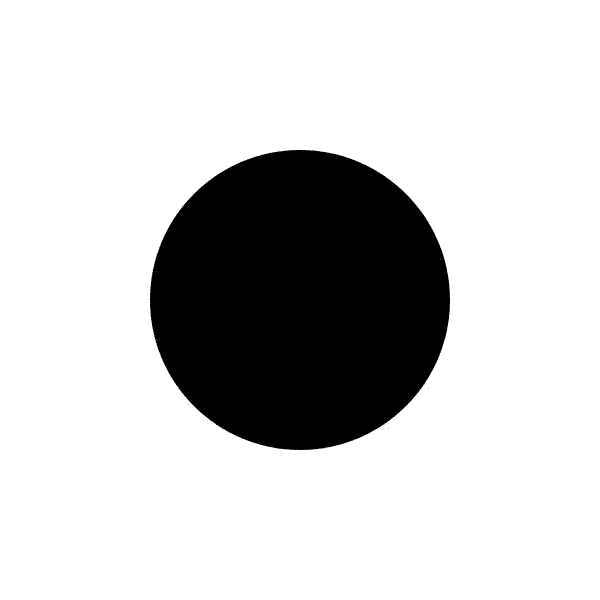
Copyright Akiyoshi Kitaoka 2010 (March 22)
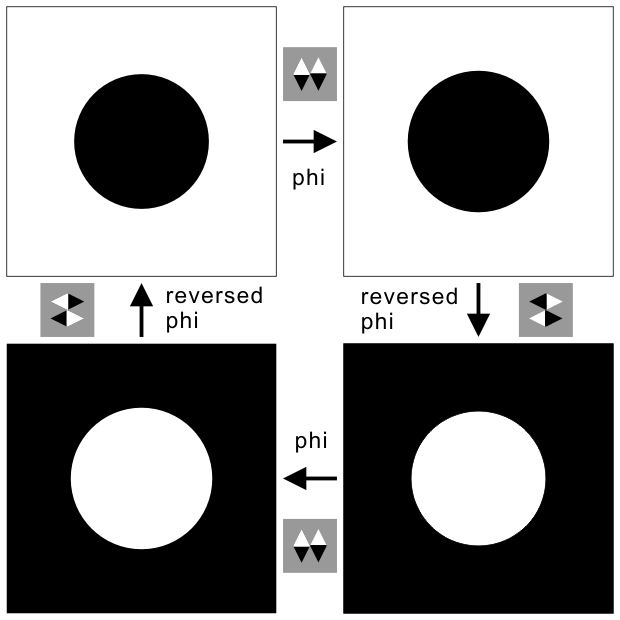
Finding: The direction of motion is the same as the tilt illusion.
cf. van Lier R, Csathó Á, 2005 “Dancing shapes: A comparison of luminance induced distortions” Perception, 35, 775 – 798.
4-stroke motion corresponding to the Mixed Type
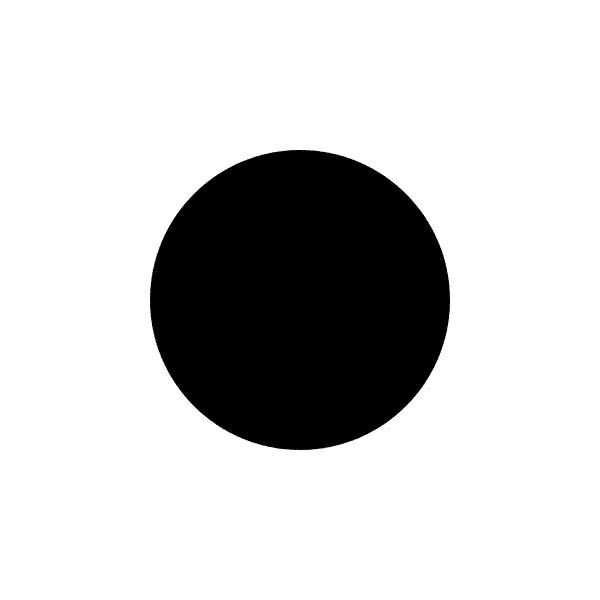
Copyright Akiyoshi Kitaoka 2010 (March 22)
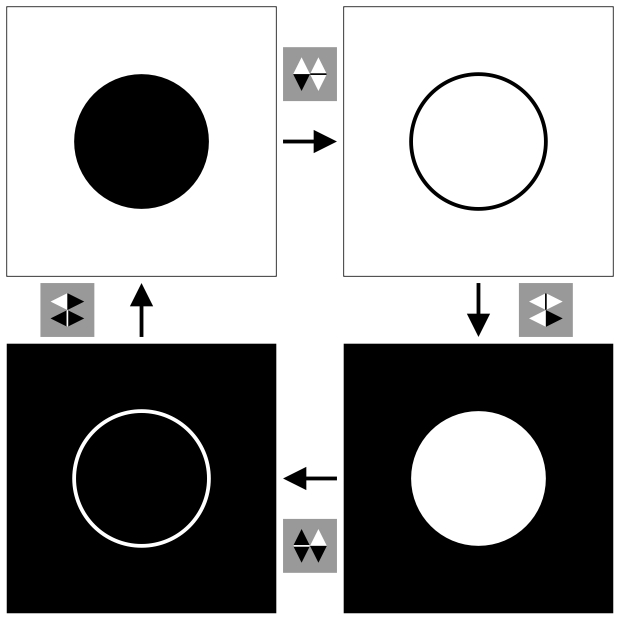
Finding: The direction of motion is the same as the tilt illusion.
<Takeuchi's four-stroke motion>
Takeuchi, T. (1997) The motion analogue of the cafe wall illusion. Perception, 26, 569-584.
Then, anomalous motion illusions that coexist in tilt illusion images can be explained in this context.
When the retinal image slides in the special direction, the orientation along which the tilt illusion occurs, the four-stroke motion is induced and anomalous motion illusion is observed.
Copyright Akiyoshi Kitaoka 2010 (June 26)
<Handout>
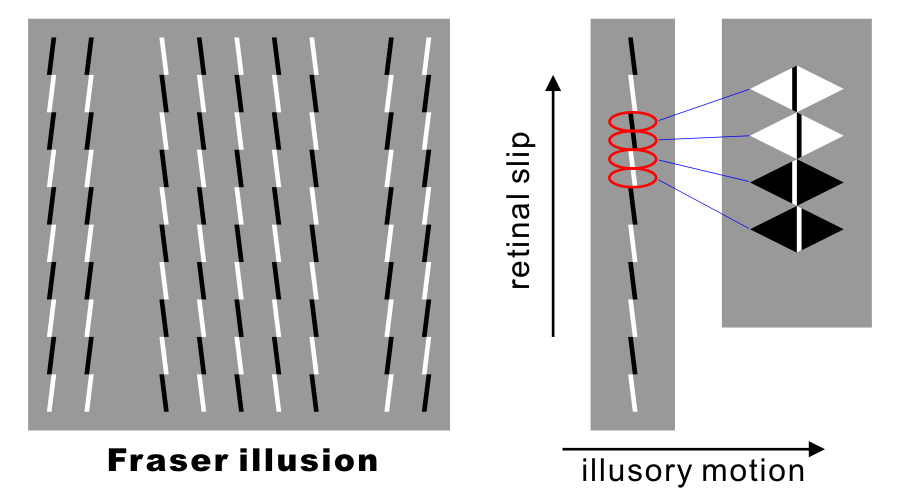
"Rain"
The inset appears to move.
Copyright Aliyoshi Kitaoka 2005 (July 2)
Explanation of the illusion of Y-junctions
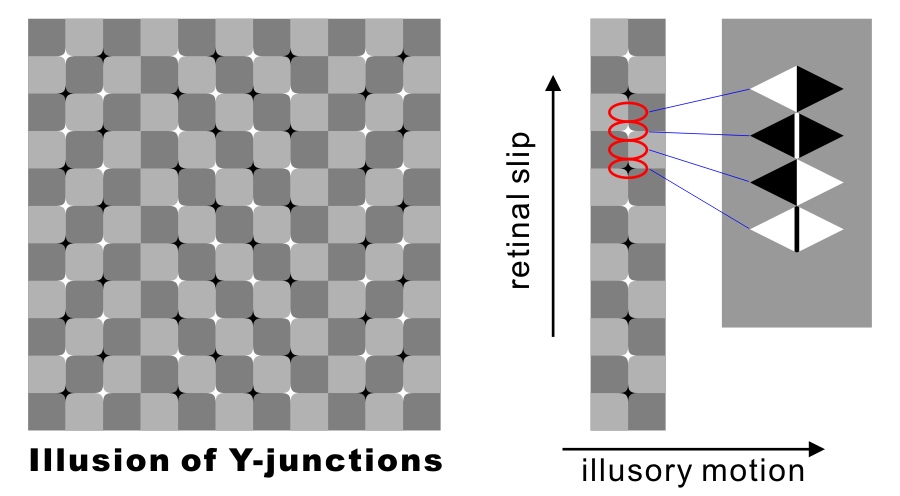
Drawn by Aliyoshi Kitaoka 2010 (June 25)

(Takeuchi's four-stroke motion)
<Two dimensional displays>

Illusion of Y-junctions
Kitaoka, A., Pinna, B., and Brelstaff, G. (2001). New variations of spiral
illusions. Perception, 30, 637-646.
Kitaoka, A., Pinna, B., and Brelstaff, G. (2004). Contrast polarities determine the direction of Cafe Wall tilts. Perception, 33, 11-20.
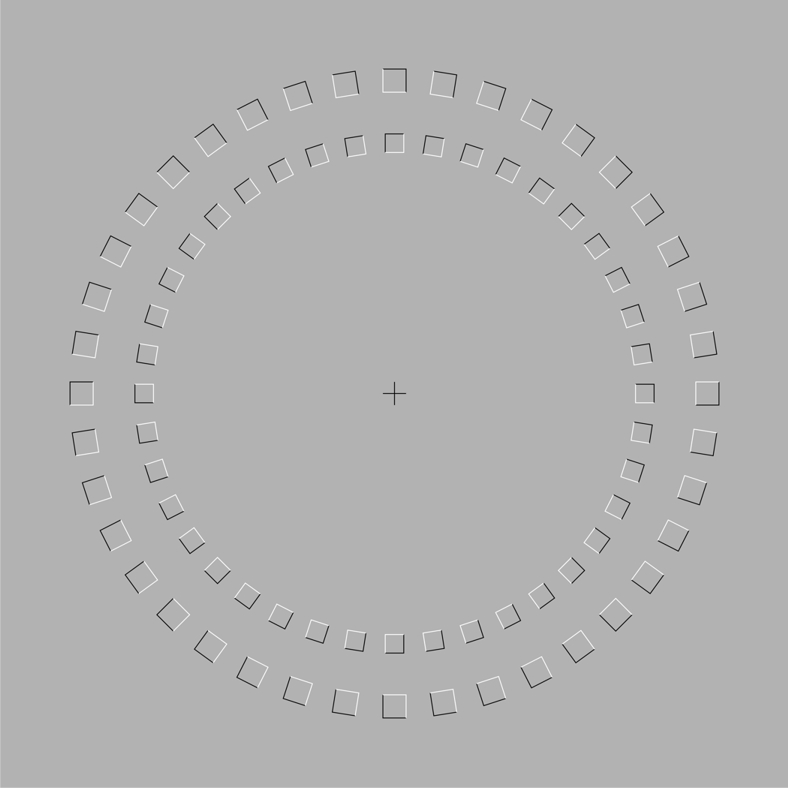
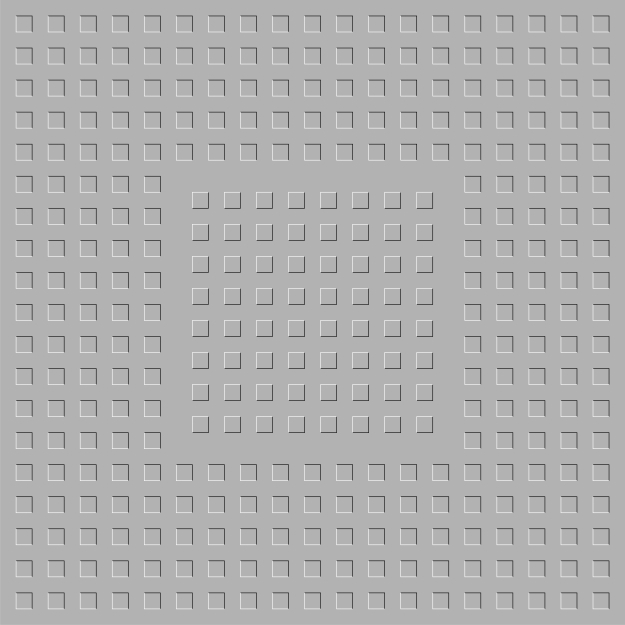
Pinna Illusion
Pinna, B. and Brelstaff, G. J. (2000) A new visual illusion of relative motion. Vision Research, 40, 2091-2096.
Explanation of the Pinna illusion
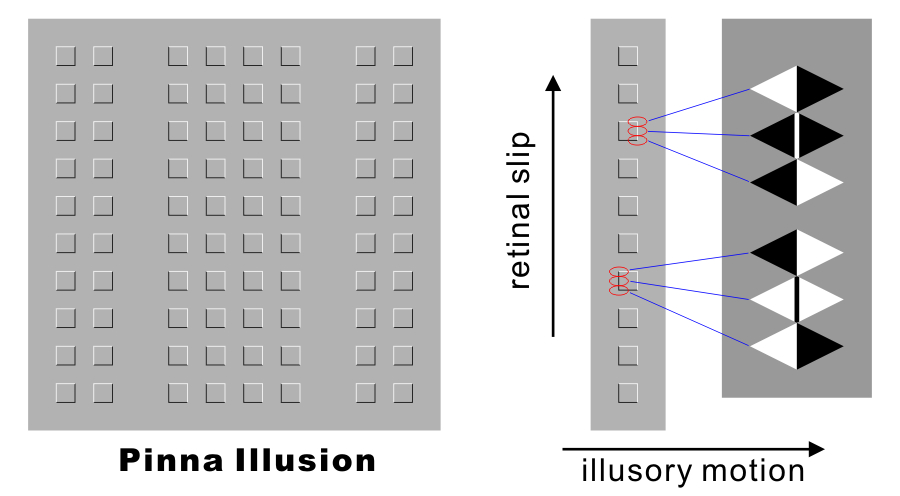
New: This idea led me to produce a novel illusion "spine drift illusion".
"Spine drift
illusion"
The inset appears to move.
Copyright Akiyoshi Kitaoka 2010 (June 4)
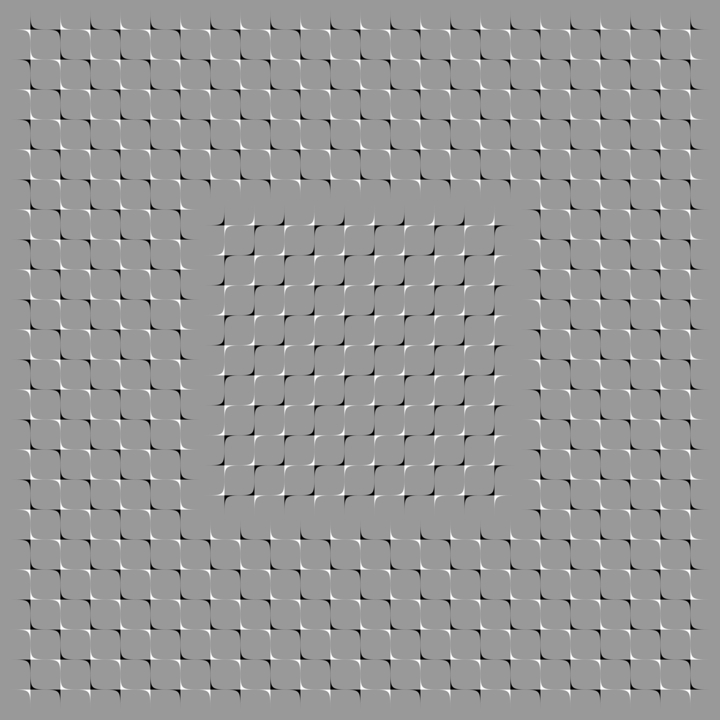
"Spine drift illusion"
The inset appears to move.
Copyright Akiyoshi Kitaoka 2010 (July 6)
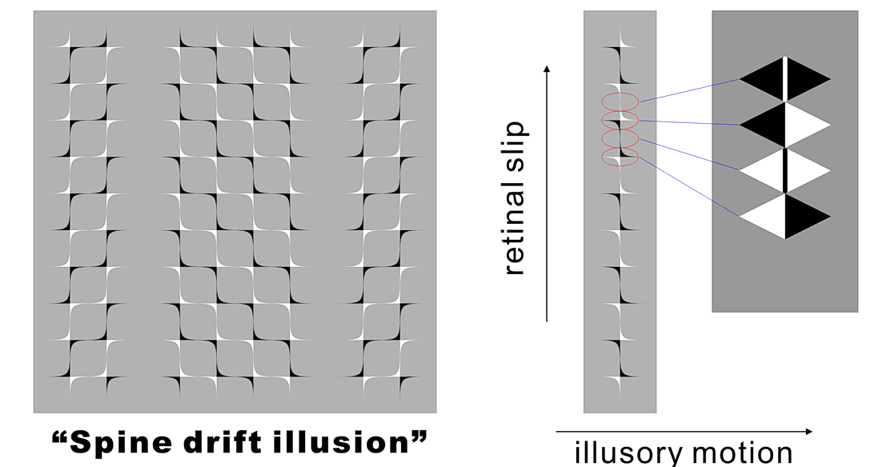
"Spine drift
illusion with the illusion of shifted lines"
The inset appears to move.
Copyright Akiyoshi Kitaoka 2010 (June 5)
"Hamburger drift
illusion"
The inset appears to move.
Copyright Akiyoshi Kitaoka 2010 (June 6)
ECVP2010(ローザンヌ)での発表
Kitaoka, A. (2010) The Fraser illusion family and the corresponding motion illusions. 33rd European Conference on Visual Perception (ECVP 2010), EPFL, Lausanne, Switzerland, 2010/8/22-26, 8/26 poster publication. Poster (Kitaoka, A. (2010) The Fraser illusion family and the corresponding motion illusions. Perception, 39, Supplement, #61, p. 178)
フレーザー・ウィルコックス錯視群
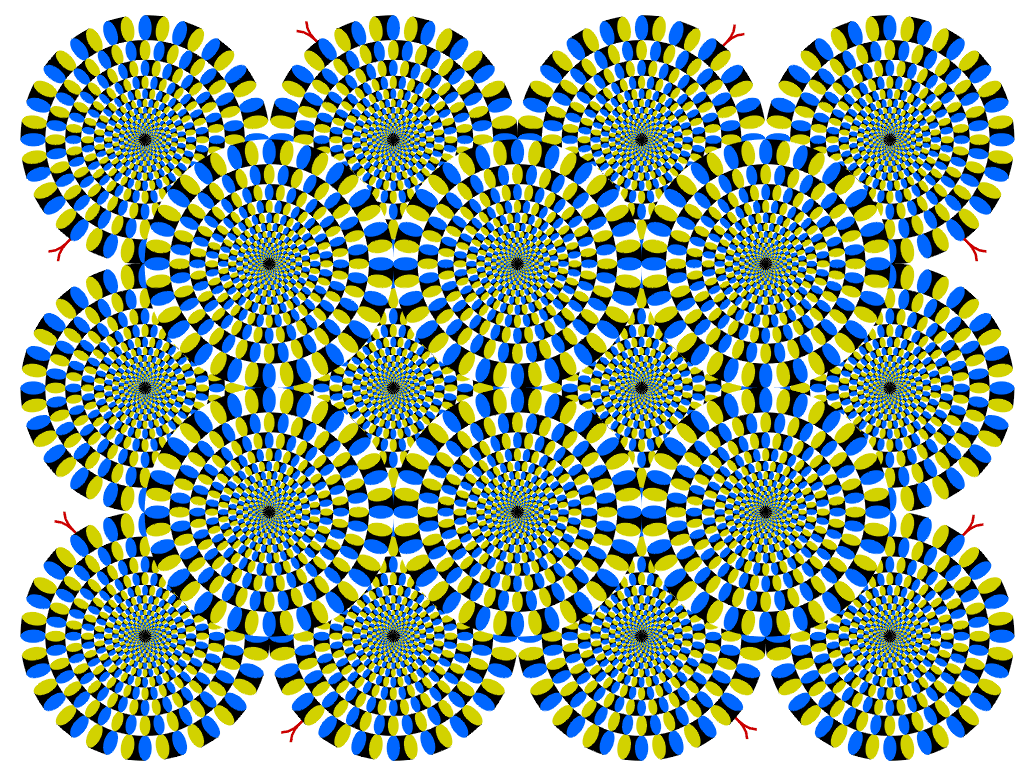
「蛇の回転」
蛇の円盤が勝手に回転して見える。
Copyright A.Kitaoka 2003 (September 2, 2003)
(配布物)
「最適化型」フレーザー・ウィルコックス錯視・タイプ I
Optimized Fraser-Wilcox illusion, Type I
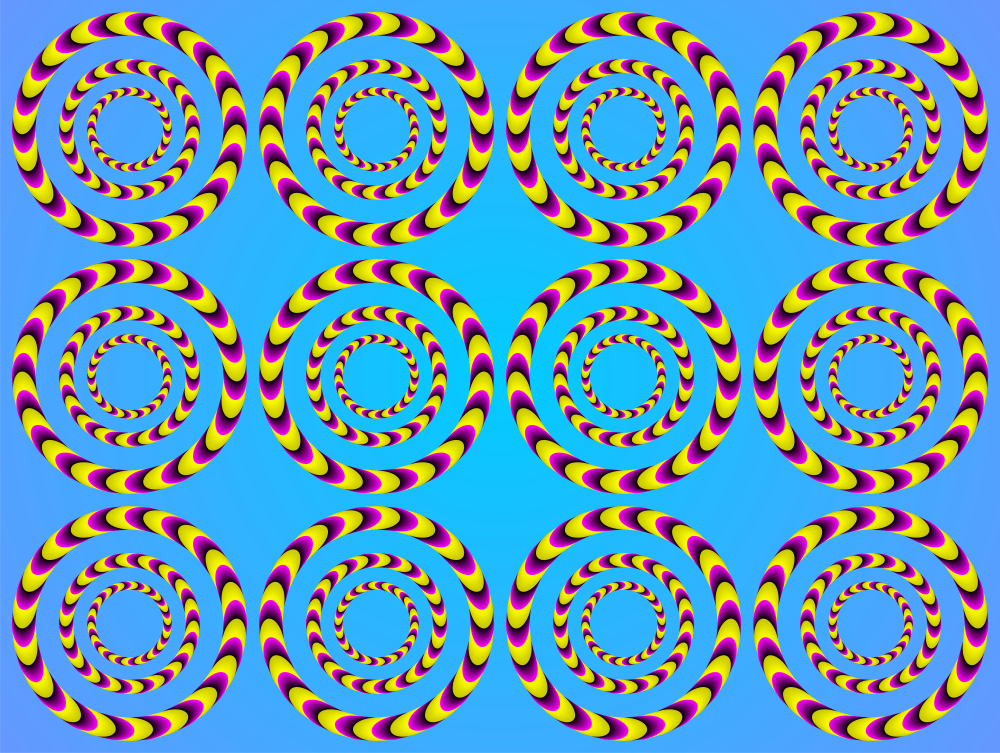
「赤い蛇の回転の詰め合わせ」
リングがゆっくり、あるいは急速に回転して見える。
Copyright Akiyoshi Kitaoka 2008 (March 19)
「最適化型」フレーザー・ウィルコックス錯視・タイプ IIa
Optimized Fraser-Wilcox illusion, Type IIa
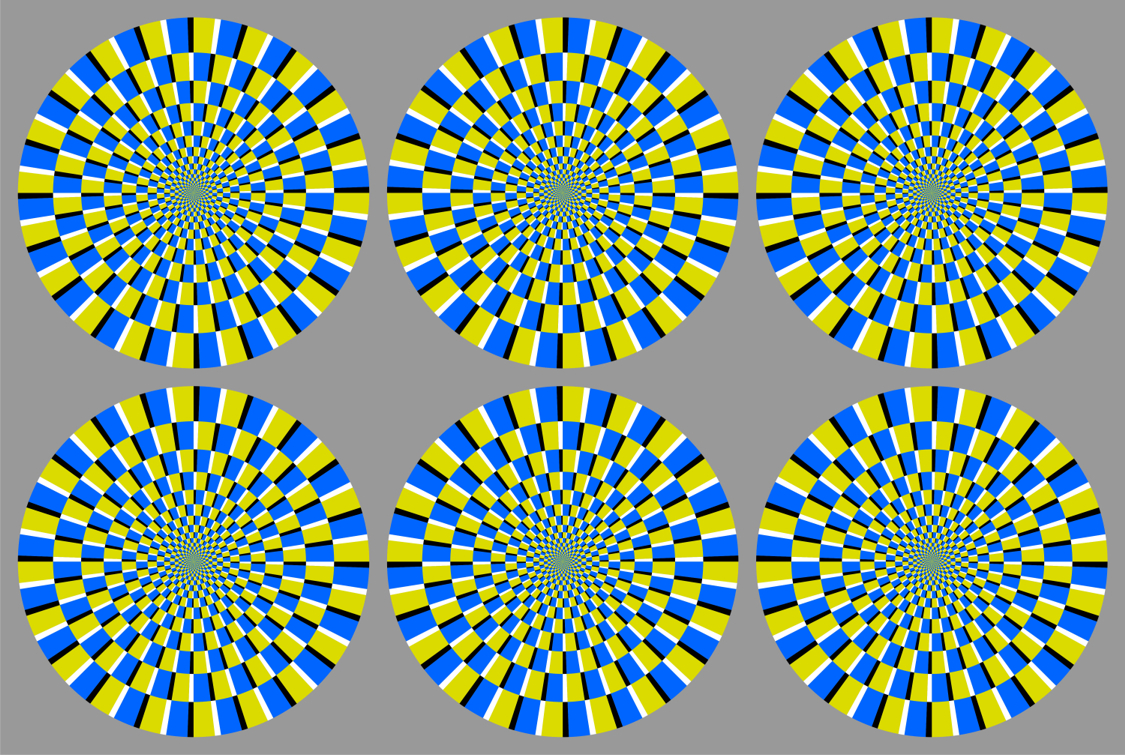
「最適化型」フレーザー・ウィルコックス錯視・タイプ III
Optimized Fraser-Wilcox illusion, Type III
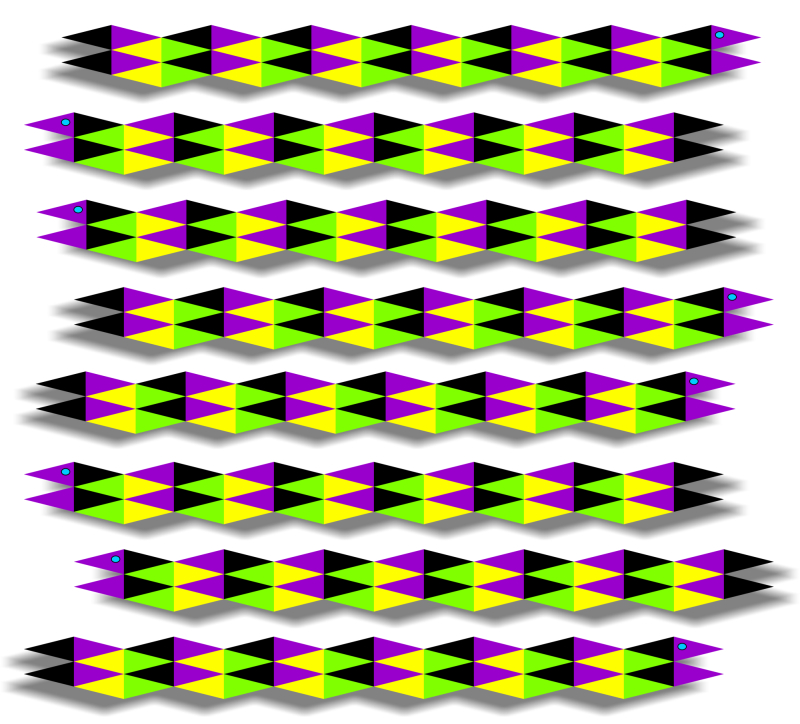
「影付きの左右に動く蛇」
蛇が左右に動いて見える。
Copyright Akiyoshi Kitaoka 2009 (June 7)
「最適化型」フレーザー・ウィルコックス錯視・タイプ IV
Optimized Fraser-Wilcox illusion, Type IV
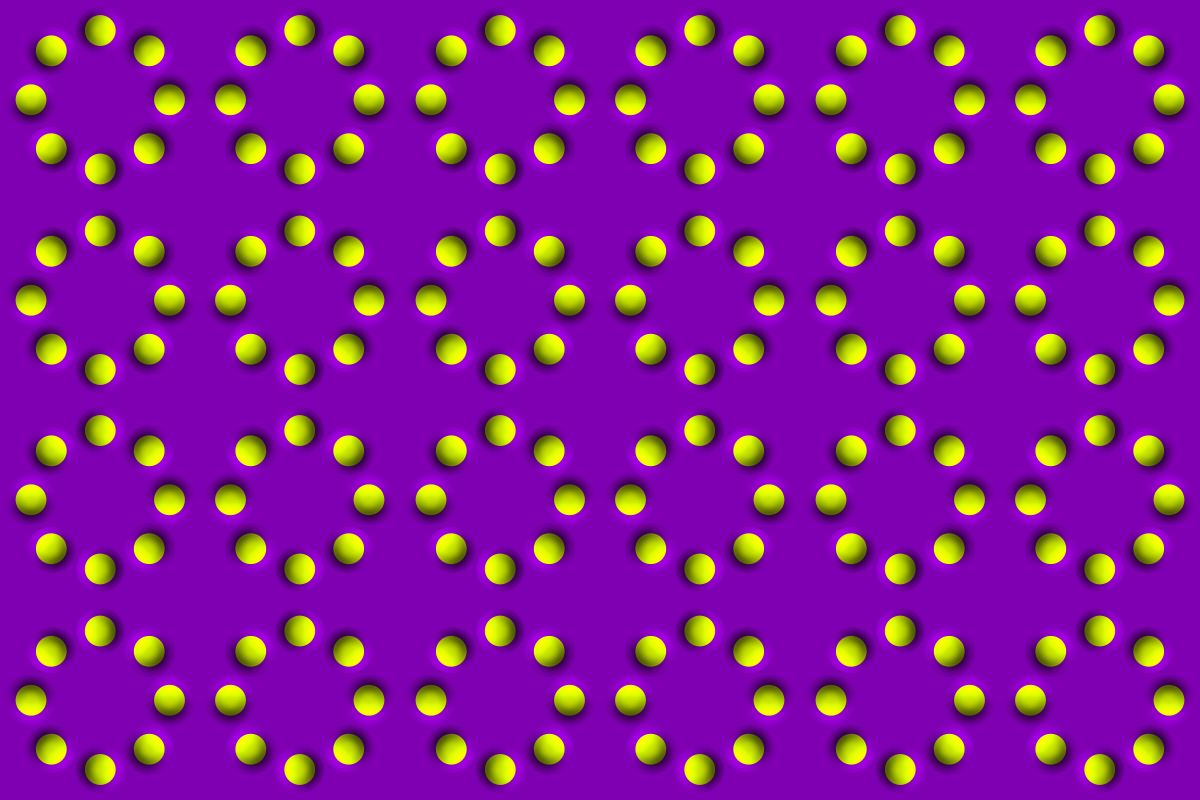
「錠剤の回転」
(たくさん版)
錠剤のリングが回転して見える。
Copyright Akiyoshi Kitaoka 2009 (March 24)
赤と紫特有の「最適化型」フレーザー・ウィルコックス錯視・タイプ V
Optimized Fraser-Wilcox illusion, Type V
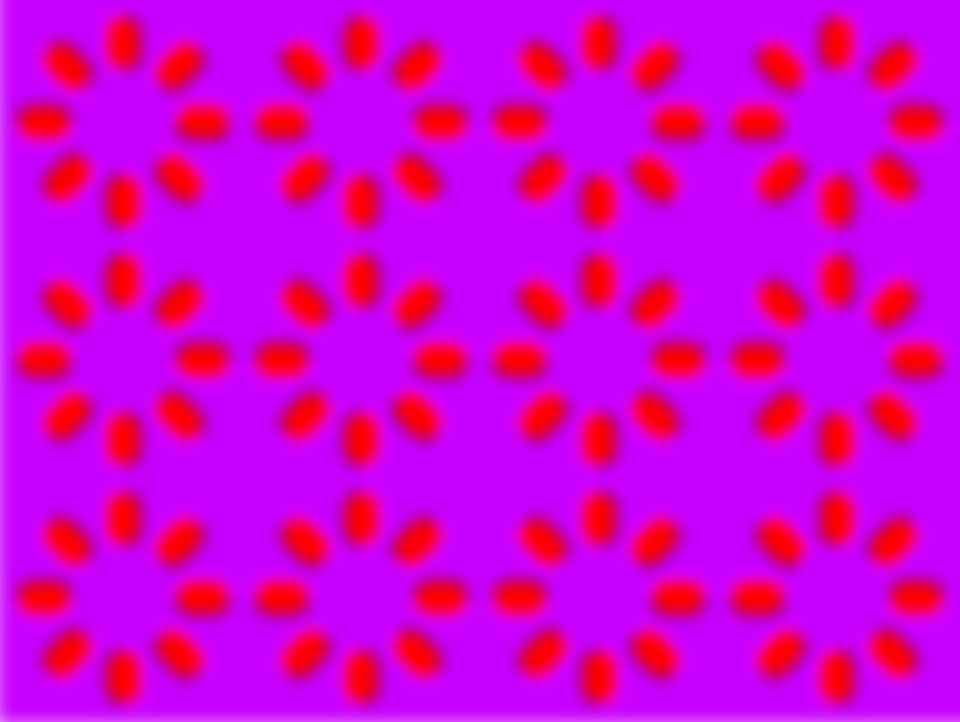
「オニシバリの実の回転」
オニシバリの実のリングが回転して見える。
Copyright Akiyoshi Kitaoka 2008 (December 19)
最適化型フレーザー・ウィルコックス錯視・タイプVの作品いろいろ
最適化型フレーザー・ウイルコックス錯視群
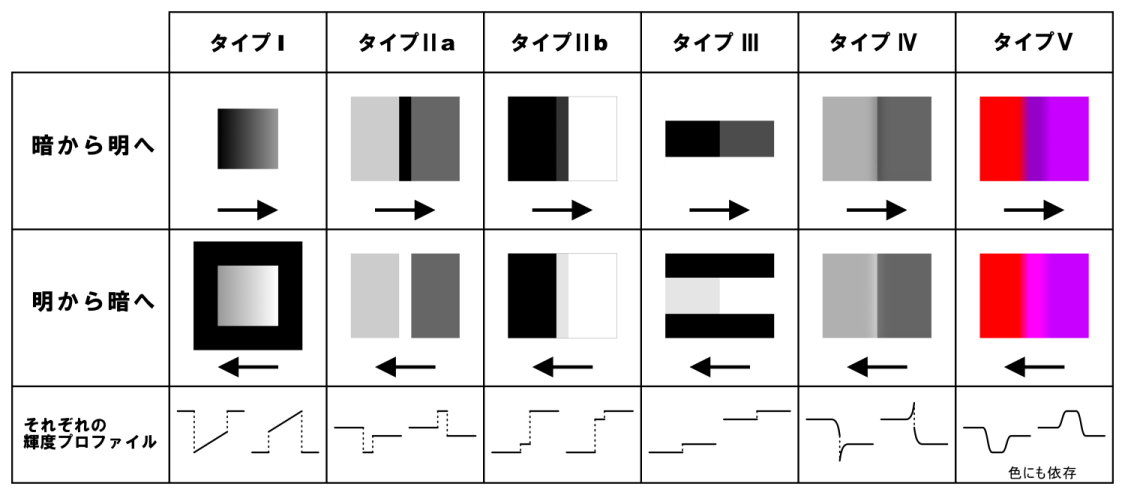
Kitaoka, A. (2007) Phenomenal classification
of the “optimized” Fraser-Wilcox illusion and the effect of color. Poster
presentation in DemoNight, VSS2007, GWiz, Sarasota, Florida, USA, May 14,
2007.
Kitaoka, A. (2008) Optimized Fraser-Wilcox illusions: A pictorial classification by Akiyoshi Kitaoka. Talk in a workshop (WS005) in the 72nd Annual Convention of the Japanese Psychological Association, Hokkaido University, Sapporo, September 19, 2008. Presentation page
北岡明佳 (2008) 人はなぜ錯視にだまされるのか? トリック・アイズ メカニズム カンゼン
これらは、 黒→濃い灰色→白→薄い灰色→黒 の方向に動いて見える錯視群である。
Direction: black → dark-gray → white → light-gray → black
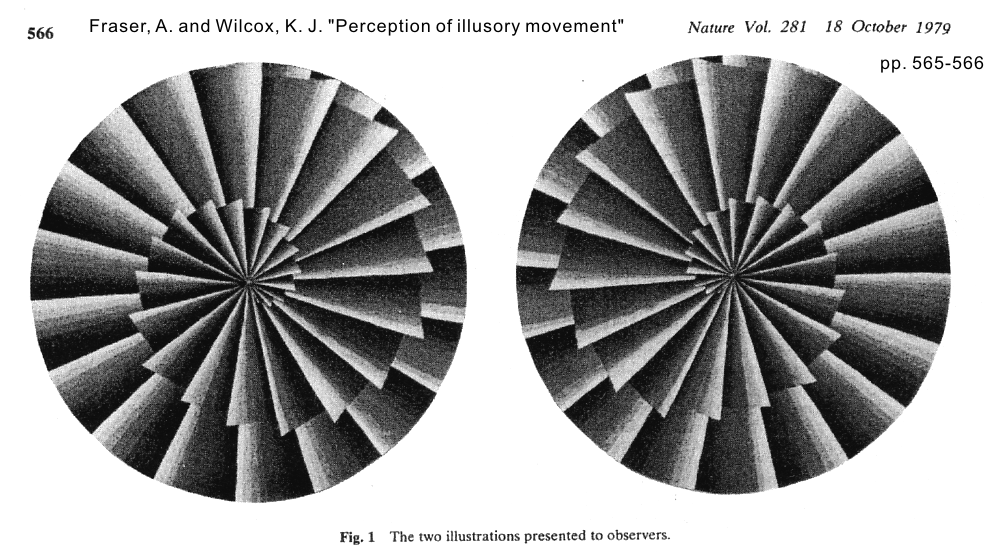
Fraser, A. and Wilcox, K. J. (1979) Perception of illusory movement. Nature, 281, 565-566.
perceptual dimorphism とその遺伝性を主張した。
Alex Fraser - Gallery of Paintings
2. Faubert and Herbert (1999)
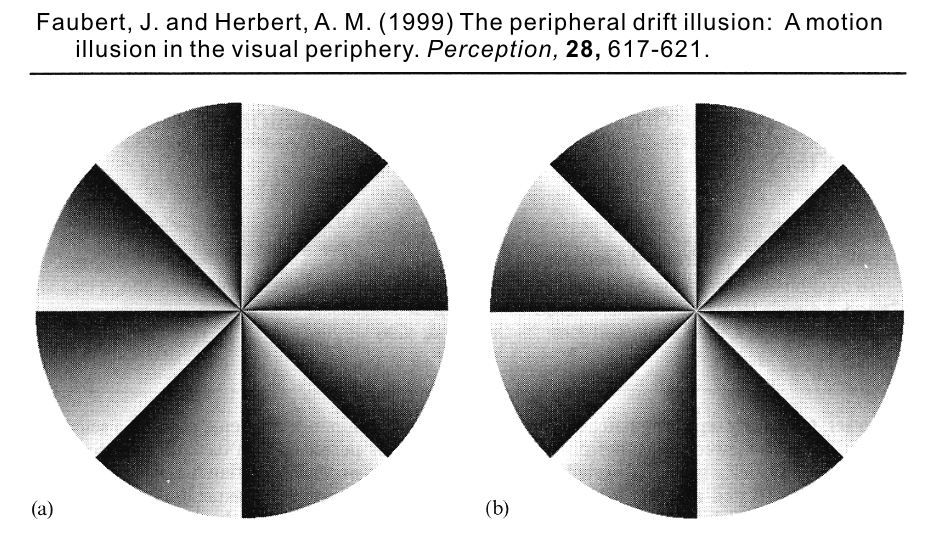
Faubert, J. and Herbert, A. M. (1999) The peripheral drift illusion: A motion illusion in the visual periphery. Perception, 28, 617-621.
3. Naor-Raz and Sekuler (2000)
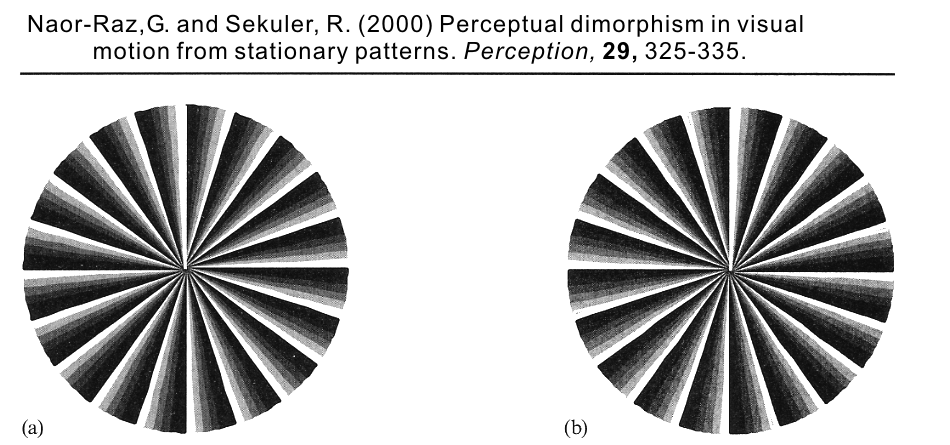
Naor-Raz, G. and Sekuler, R. (2000) Perceptual dimorphism in visual motion from stationary patterns. Perception, 29, 325-335.
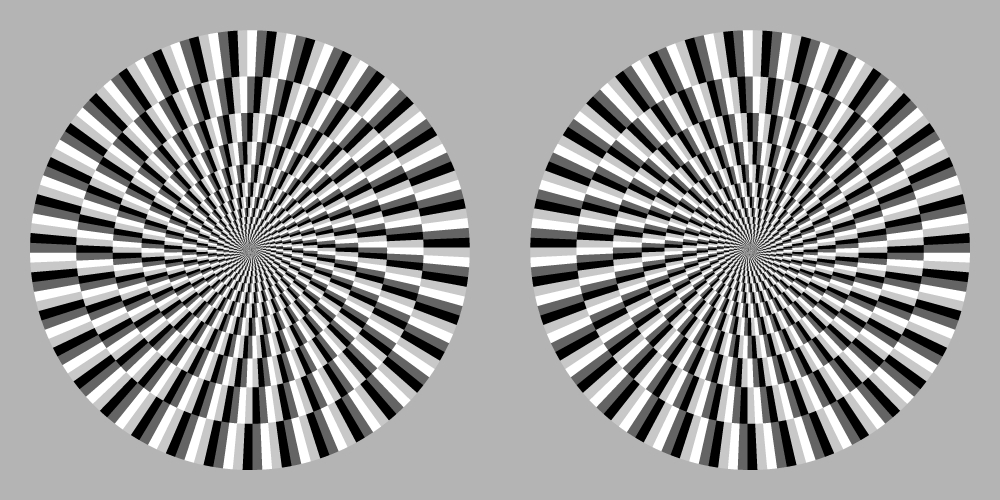
Kitaoka, A. and Ashida, H. (2003) Phenomenal characteristics of the peripheral drift illusion. VISION (Journal of the Vision Society of Japan), 15, 261-262
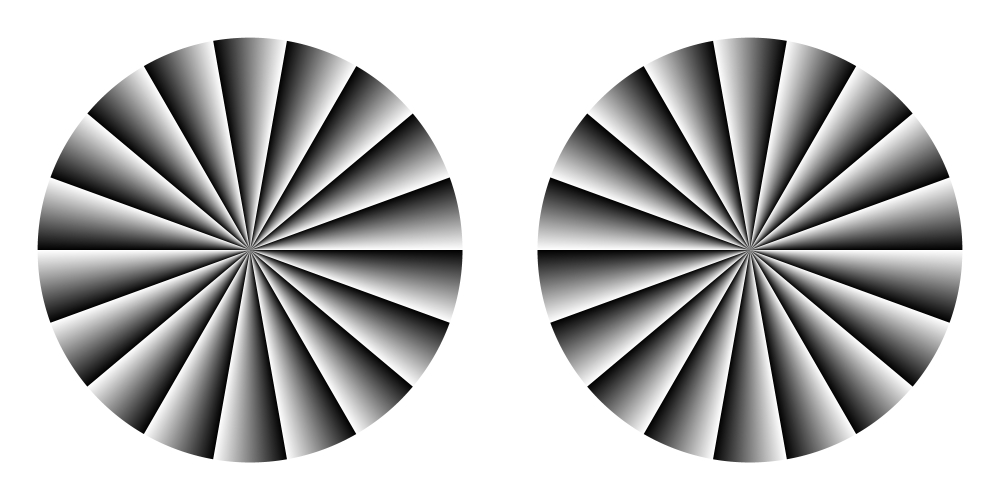
"Dark to light" (in gradation) might be stronger.
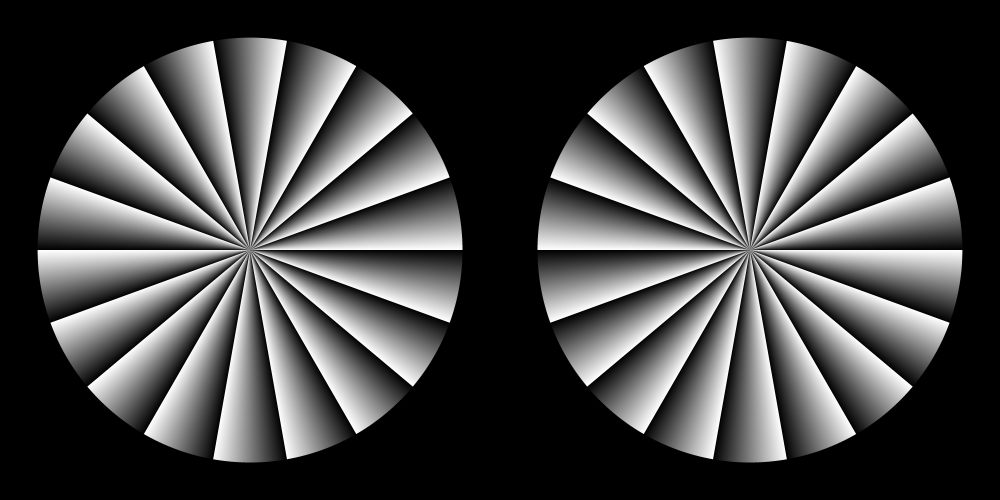
"Light to dark" might be stronger.
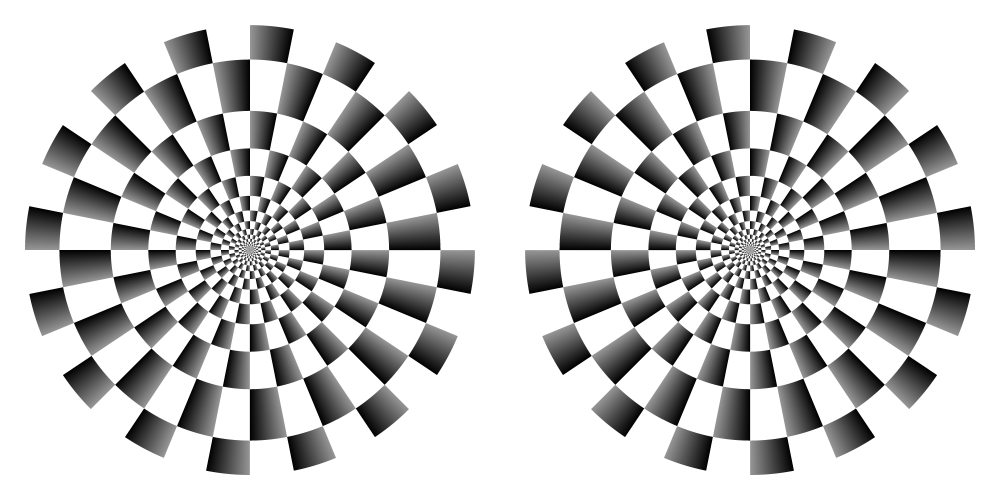
"Dark to light"
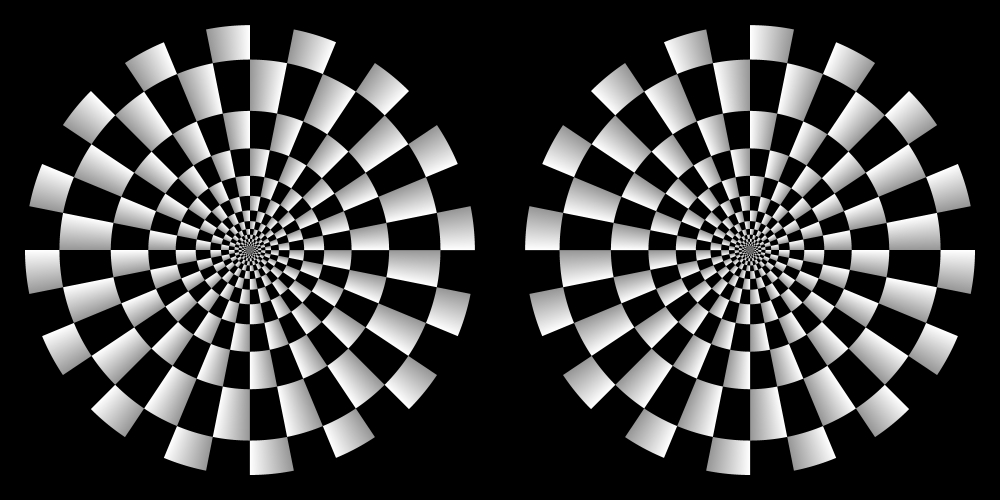
"Light to dark"
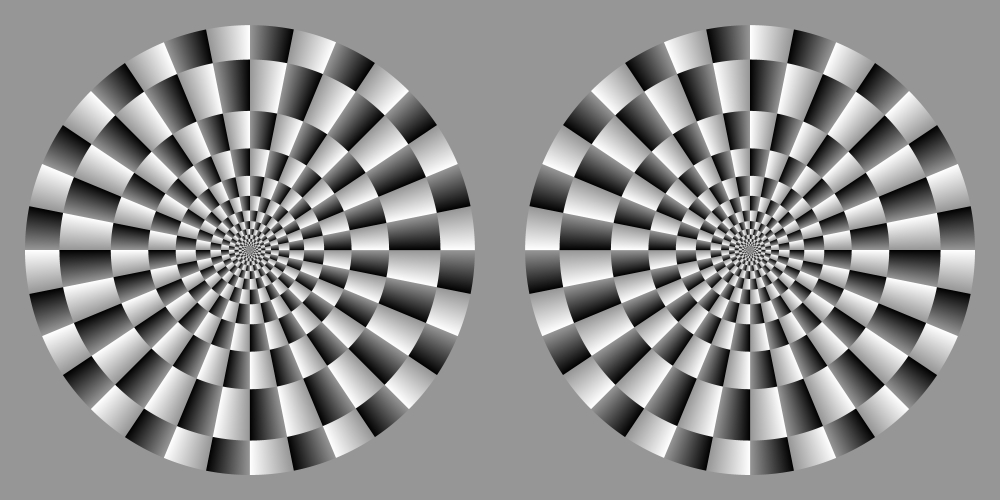
"Dark to light" and "light to dark" in cooperation
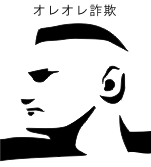 I propose an empirical observation that color might enhance the illusion
in some conditions.
I propose an empirical observation that color might enhance the illusion
in some conditions.
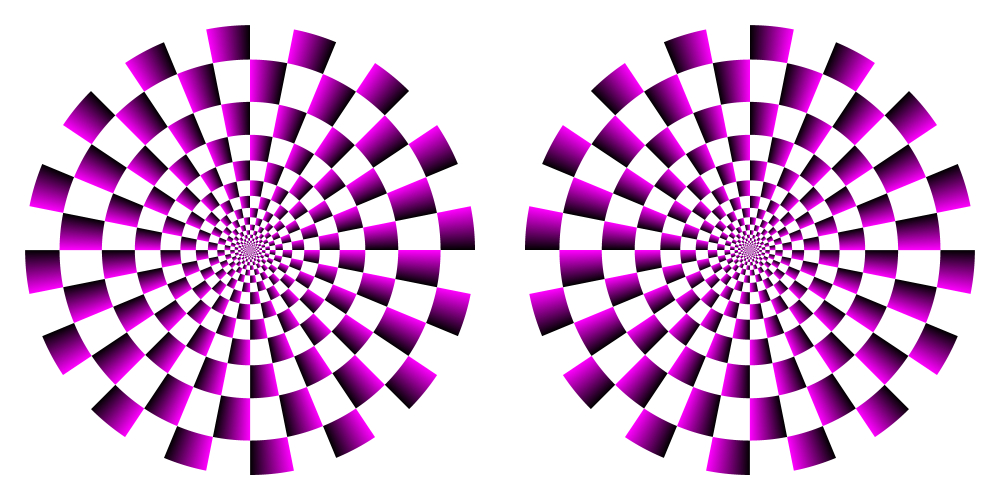
Observation 1. The illusion from dark to light is enhanced by red or blue.
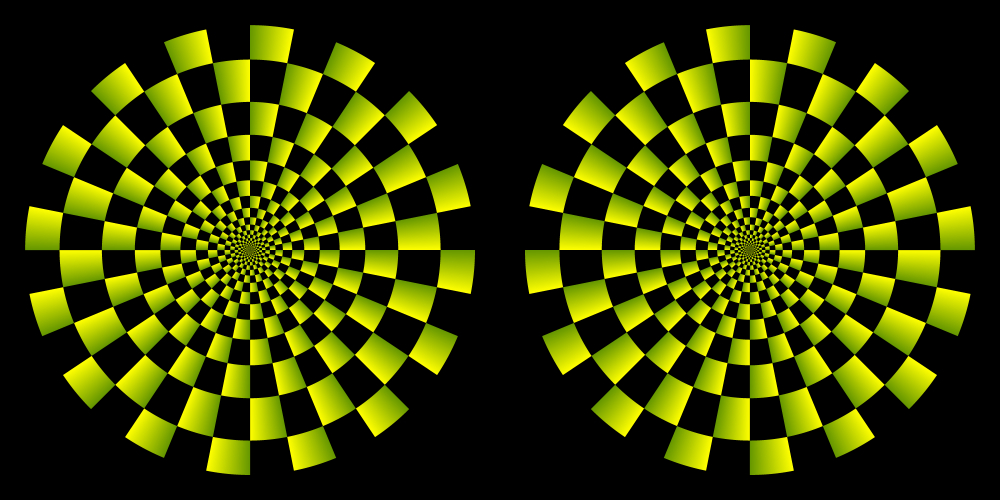
Observation 2. The illusion from light to dark is enhanced by yellow or green.
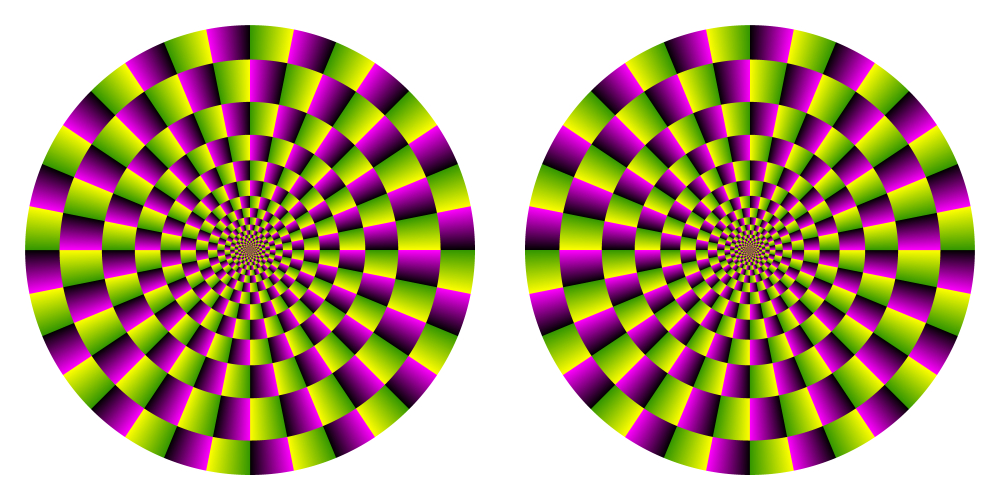
Observation 3. The illusion from dark to light is enhanced by red or blue, while the illusion from light to dark is enhanced by yellow or green. Both illusions work additively.
 最近の発見で、またややこしいことに・・・
最近の発見で、またややこしいことに・・・フレーザー・ウィルコックス錯視図の一種(背景は灰色)
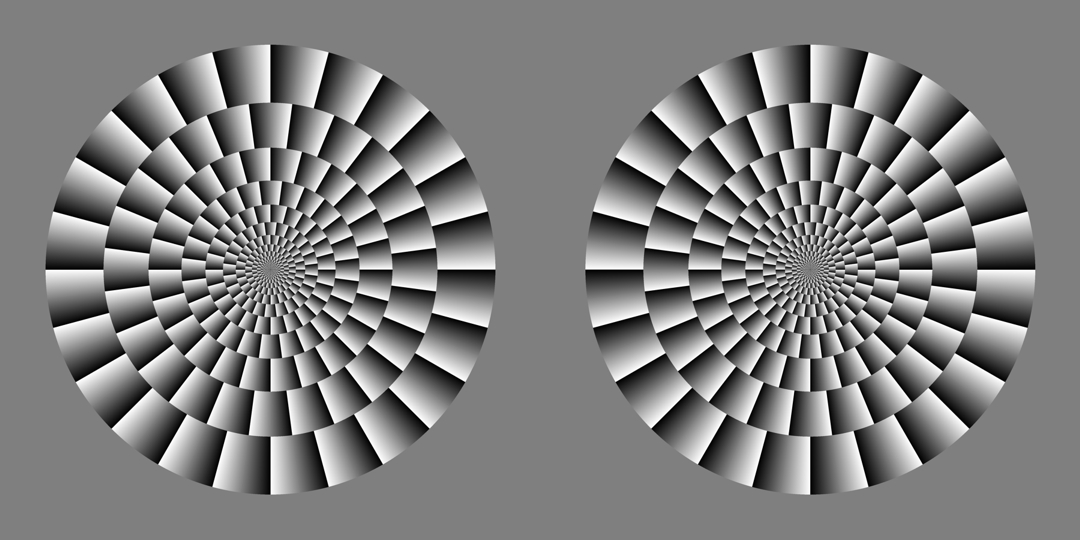
Darkening disambiguation
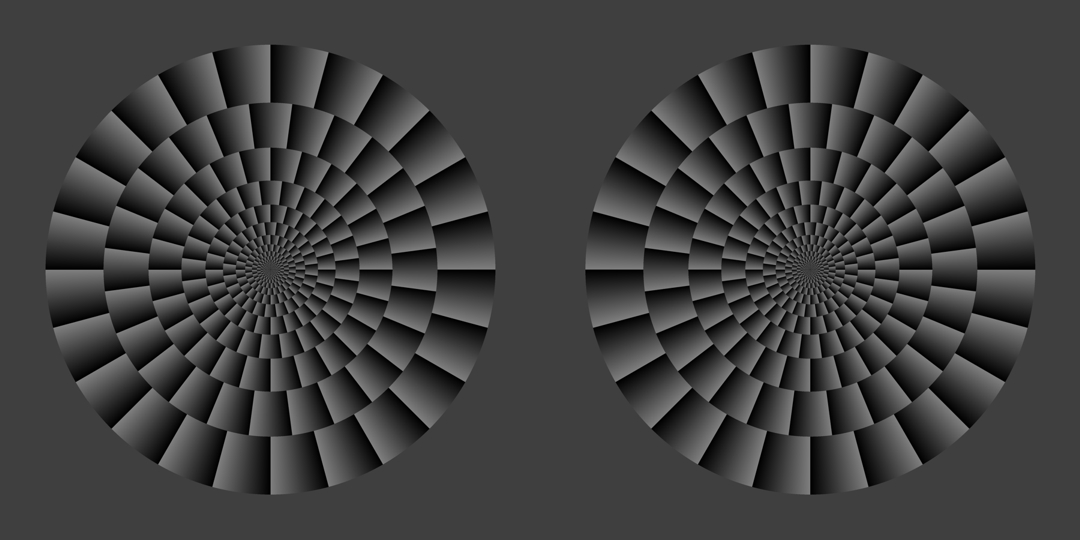
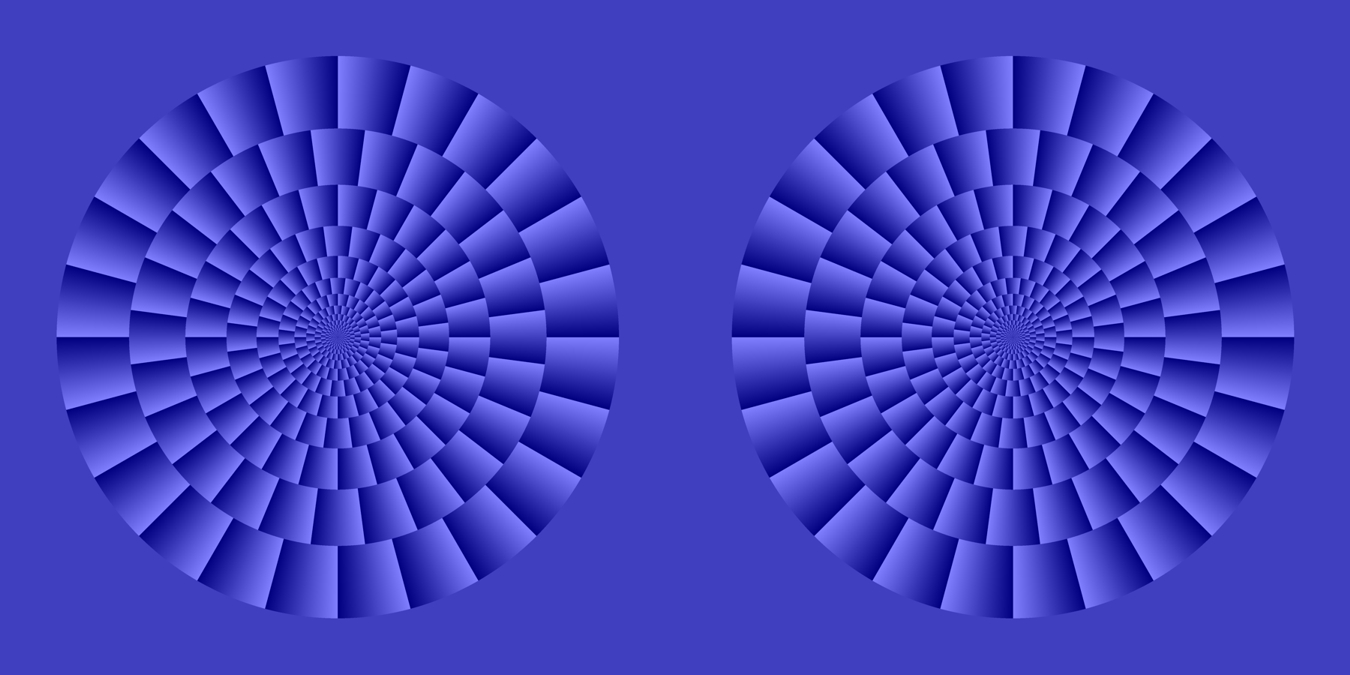
赤いと反対方向
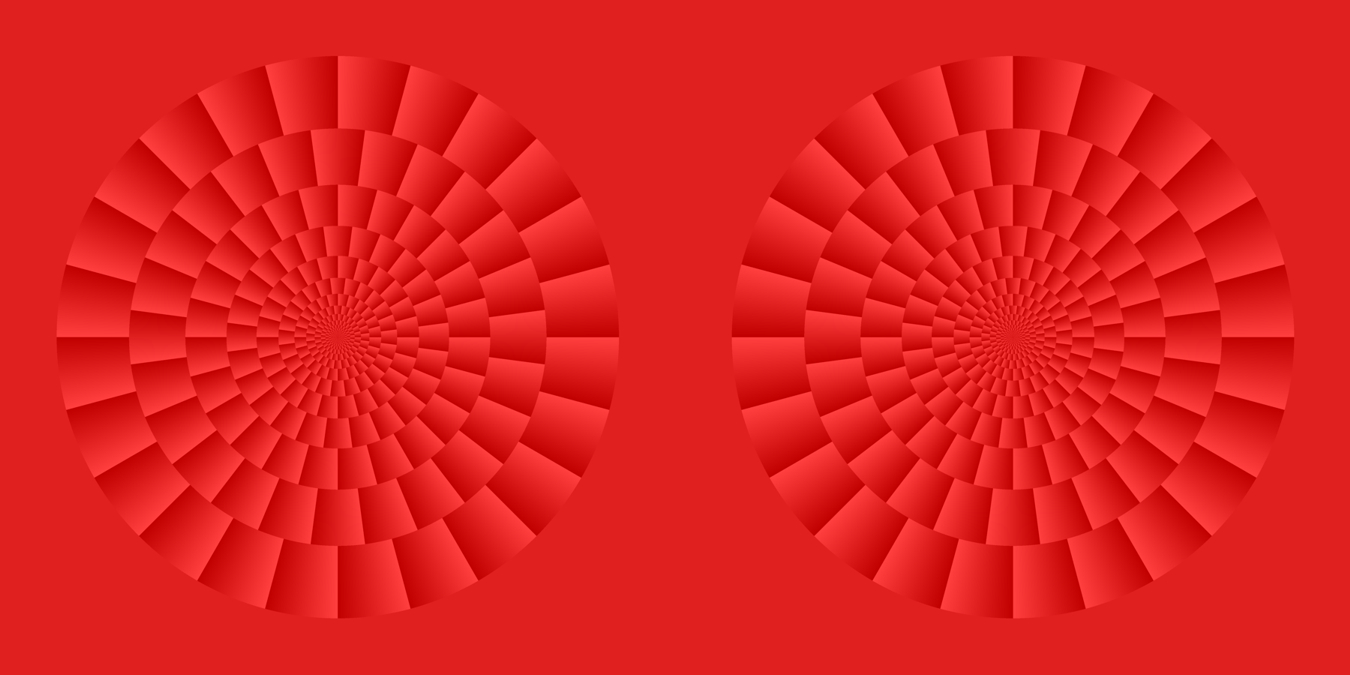
グラデーションは関係なし?
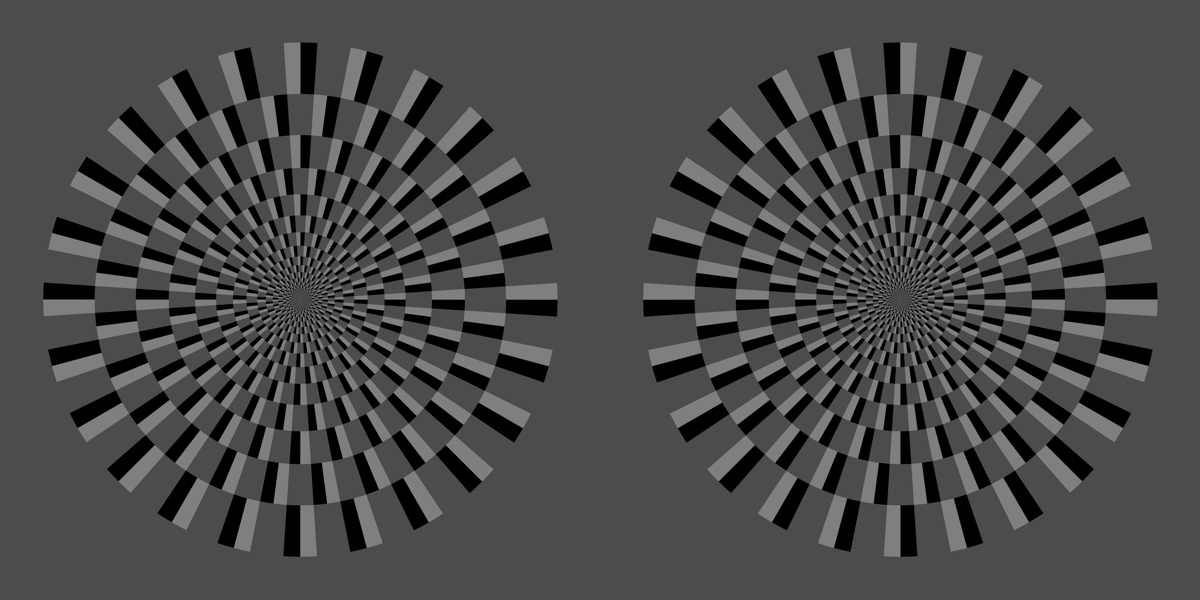
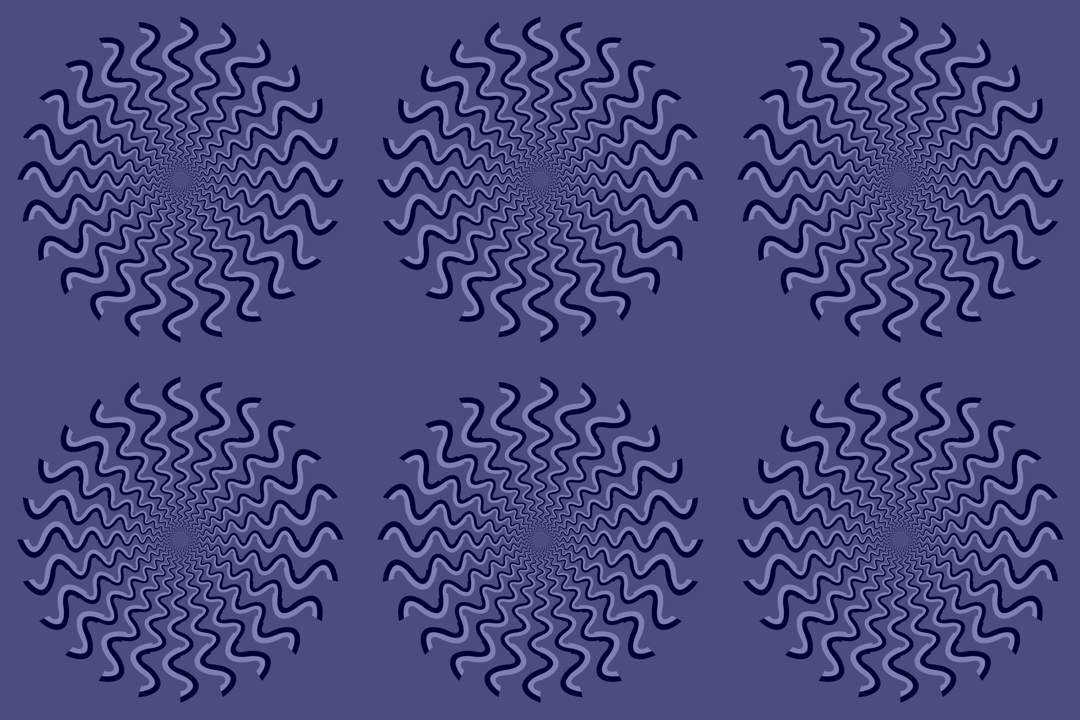
赤い perceptual dimorphism
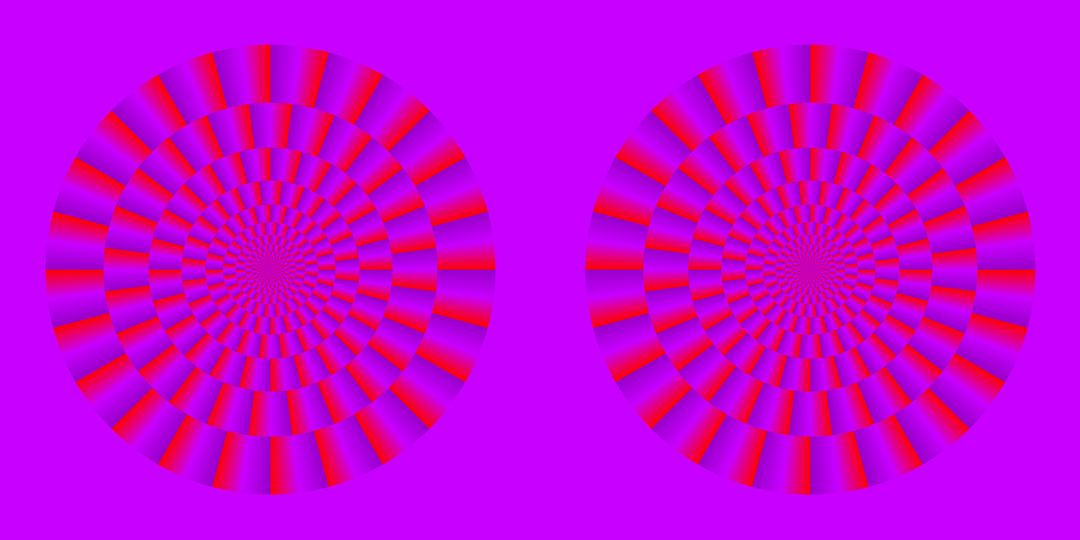
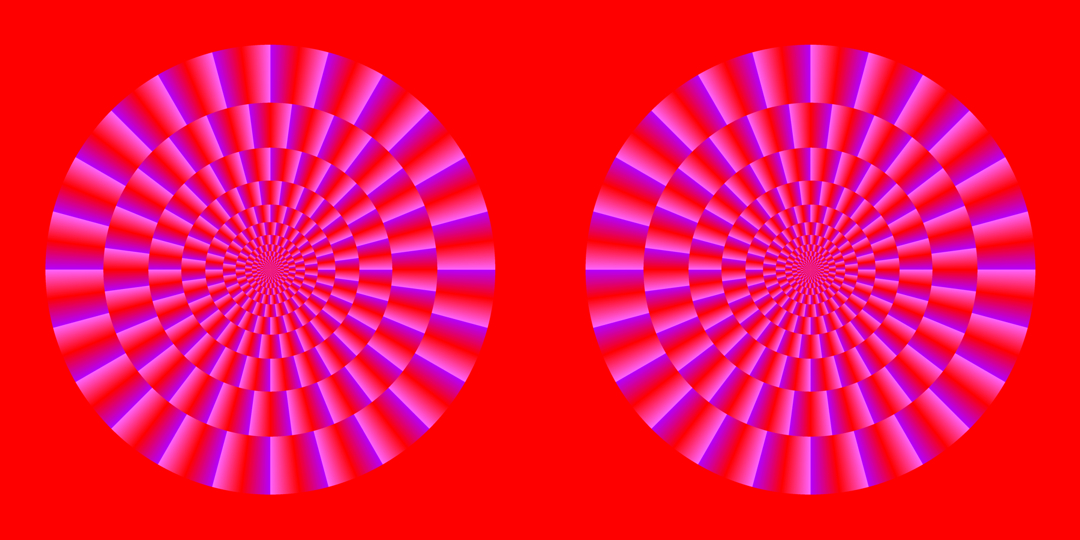
赤い perceptual dimorphism もグラデーションは不要?
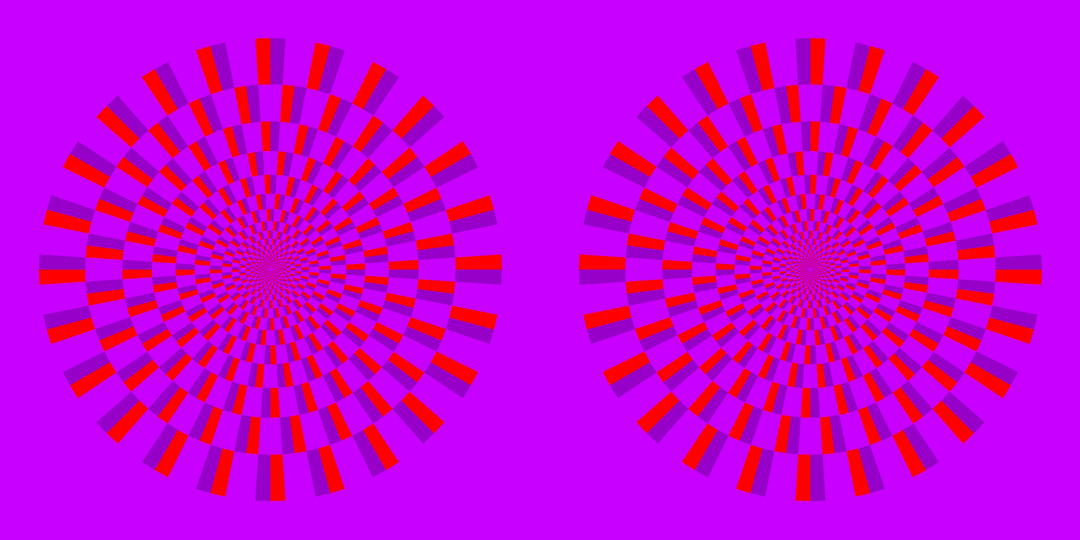
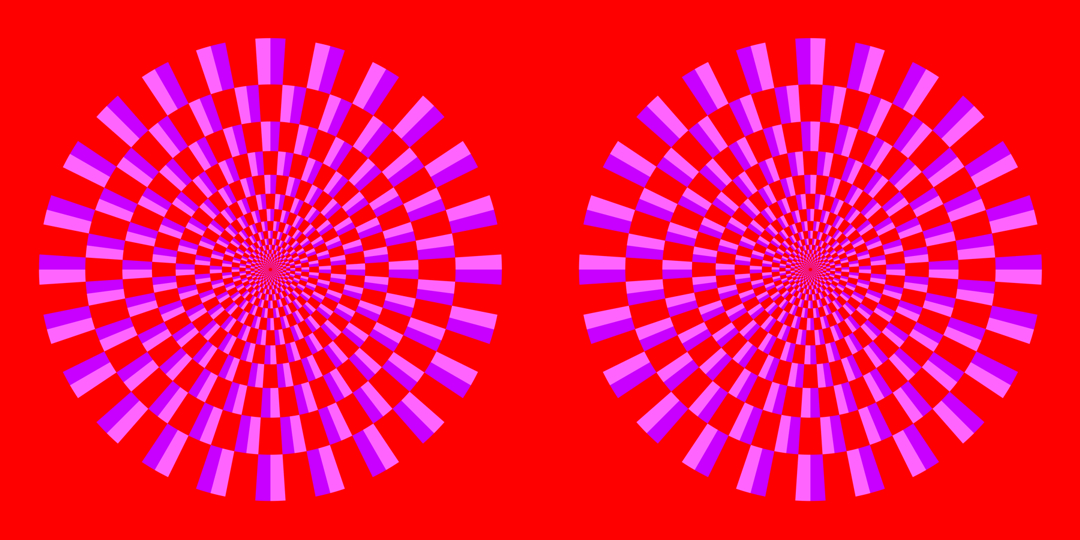
「フレーザー・ウィルコックス錯視族のレビュー」論文
Kitaoka, A. (2012?) The Fraser-Wilcox illusion and its extension. Shapiro, A. and Todorovic, D. (Eds.), Oxford Compendium of Visual Illusions. Oxford University Press.
を乞うご期待
参考書
北岡明佳著 錯視入門 朝倉書店 (2010年7月) ![]() new!
new!
北岡明佳著 人はなぜ錯視にだまされるのか? トリック・アイズ メカニズム カンゼン (2008年7月刊行) ![]() new!
new!
北岡明佳(監修) ニュートン別冊 脳はなぜだまされるのか? 錯視
完全図解 (2007年10月刊行) ![]()
北岡明佳著 だまされる視覚 錯視の楽しみ方 化学同人 (2007年1月刊行) 好評発売中 ![]()

まとめ
錯視を網膜説で検討することは大切と考えられる。
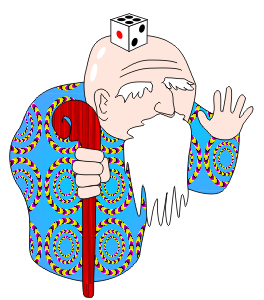 ご清聴ありがとうございました。
ご清聴ありがとうございました。
